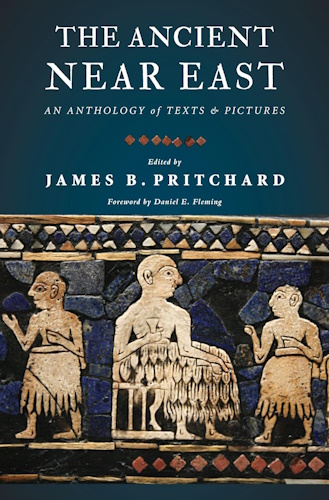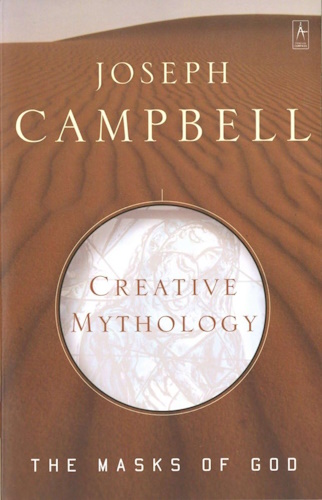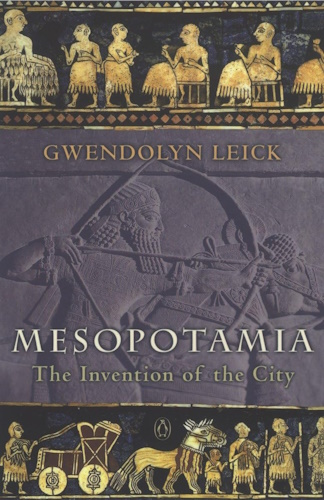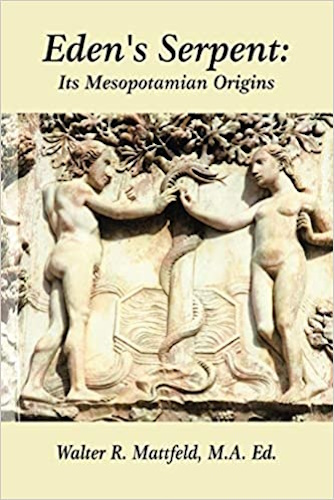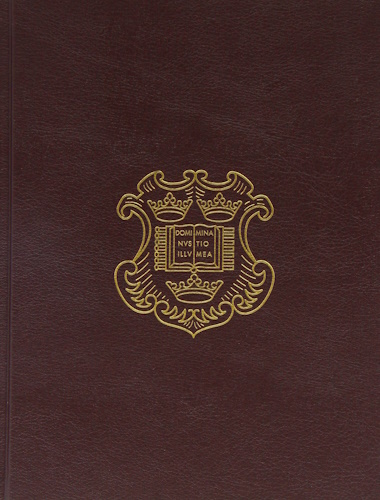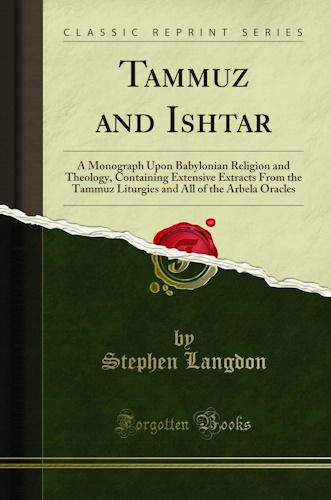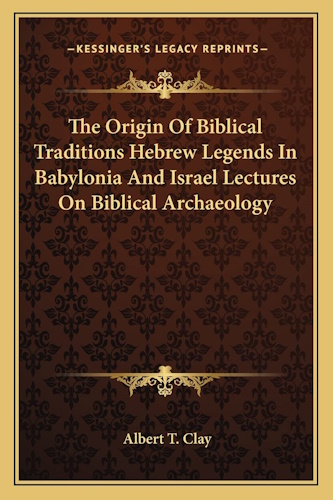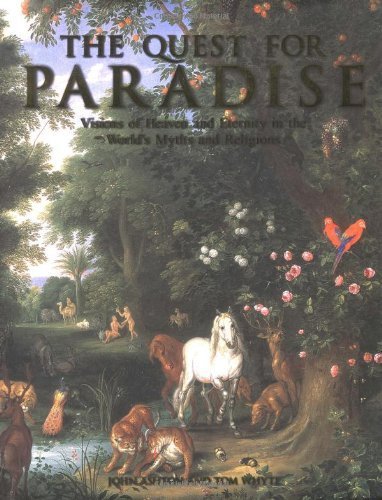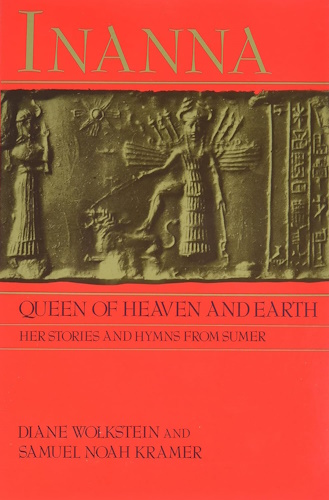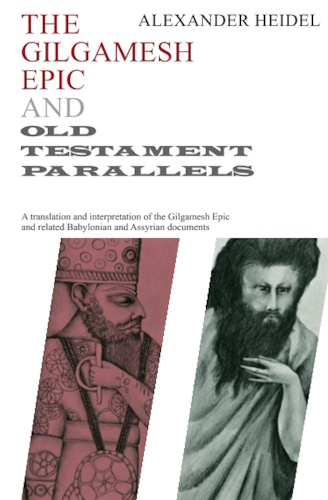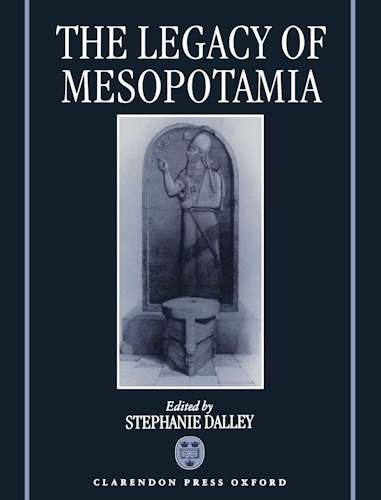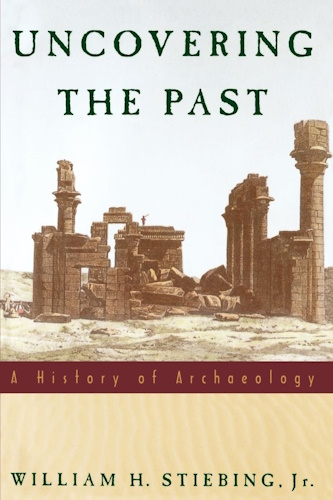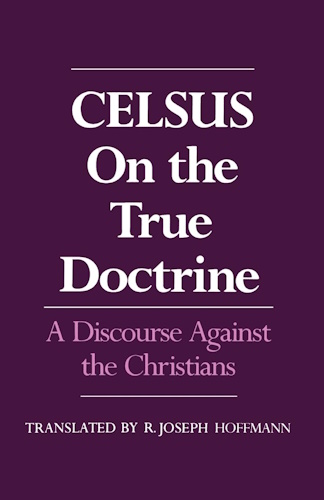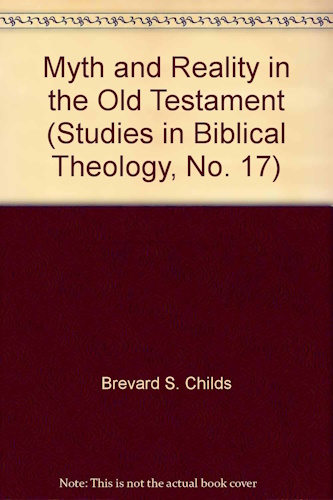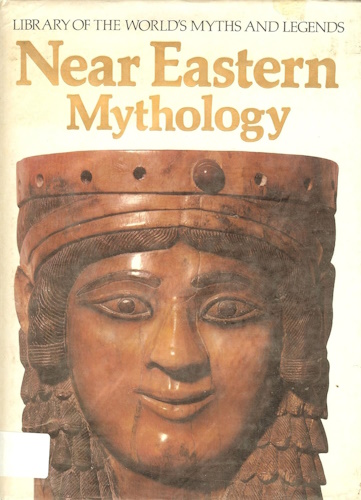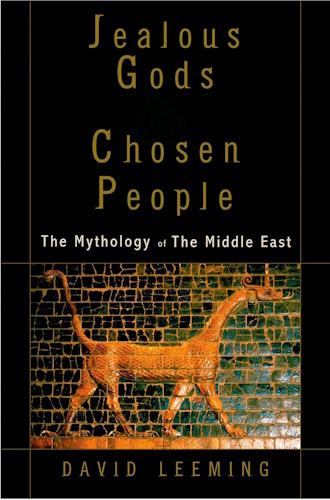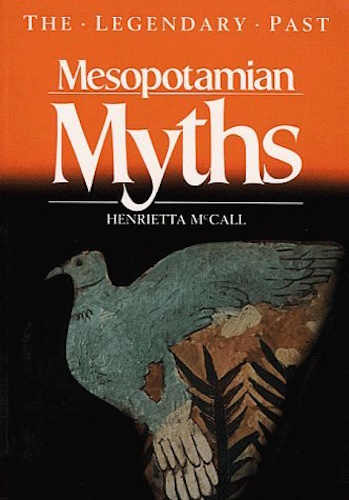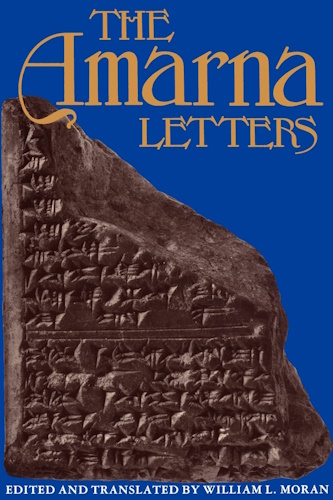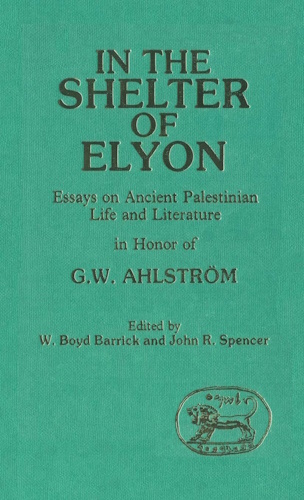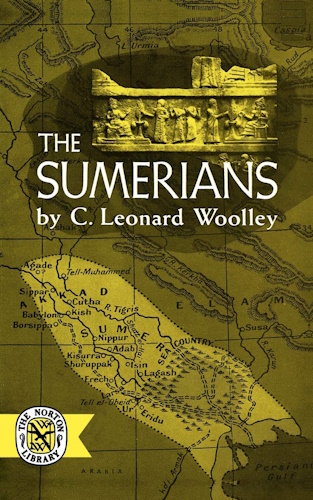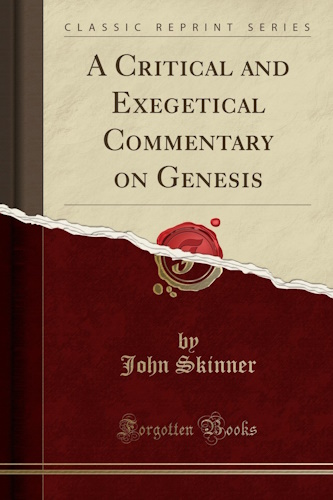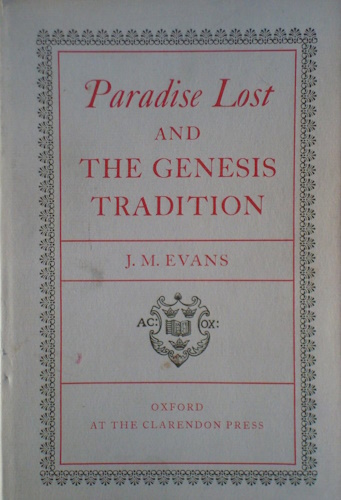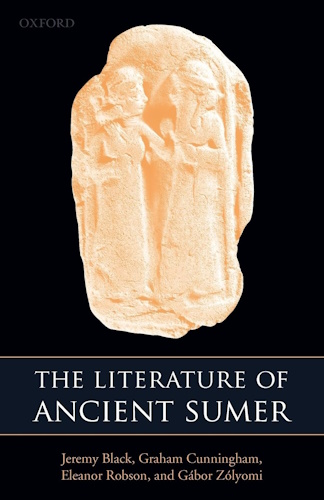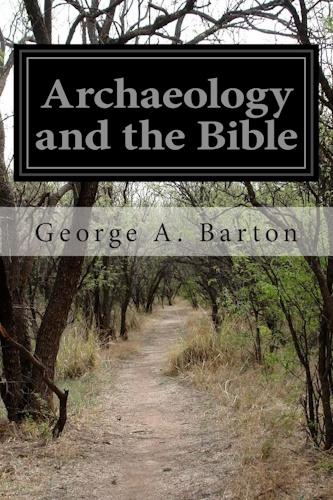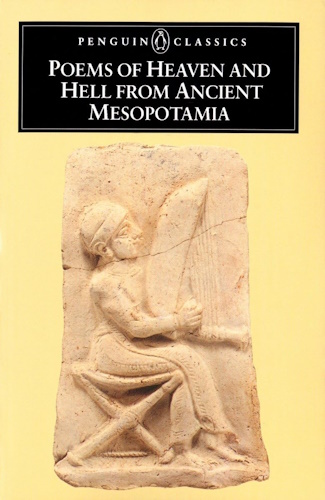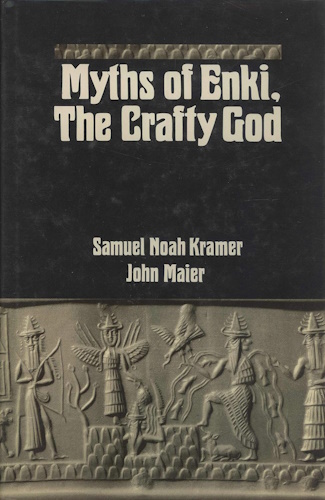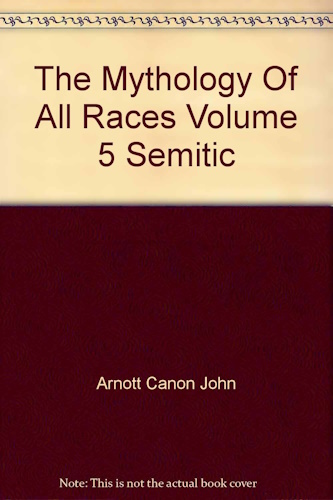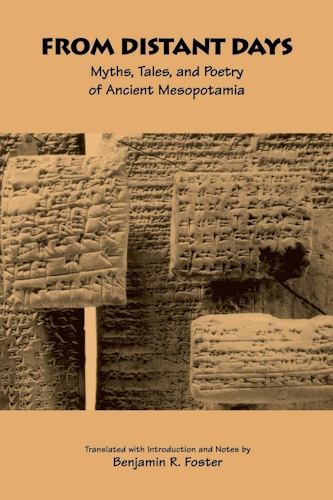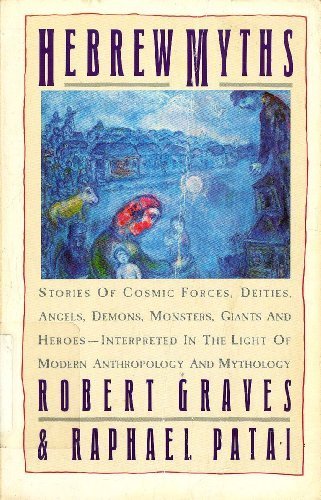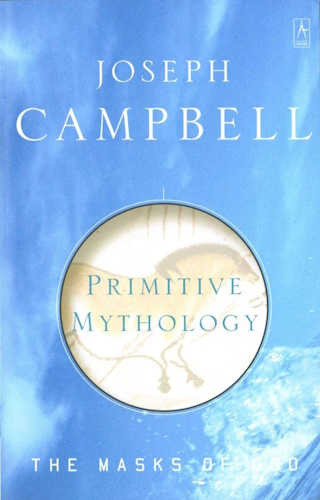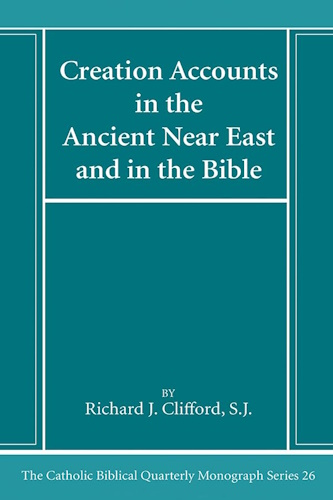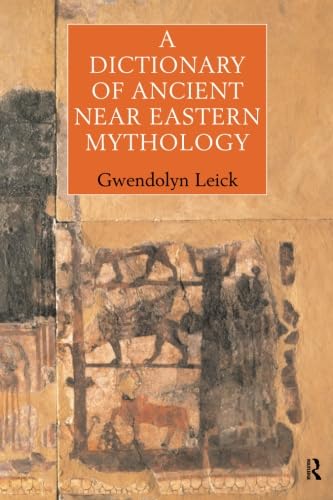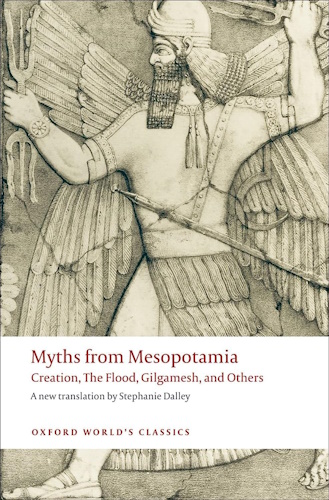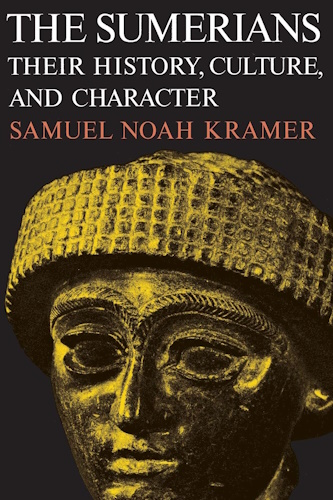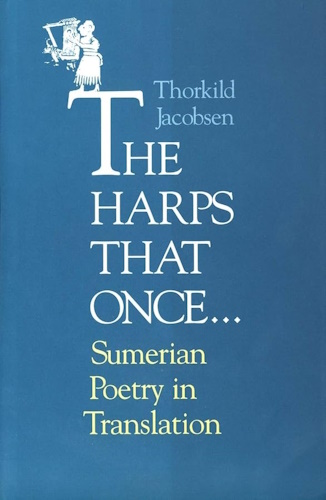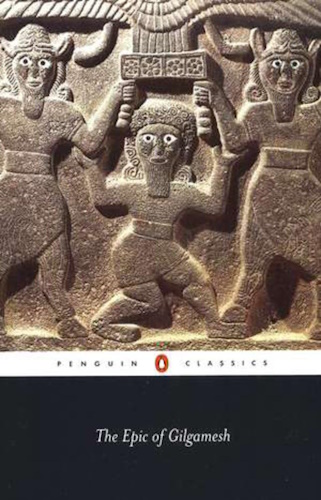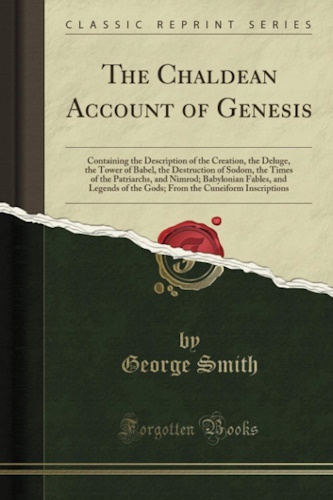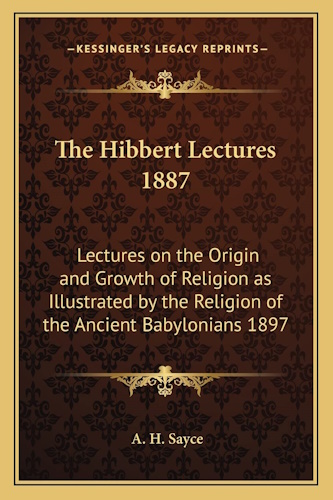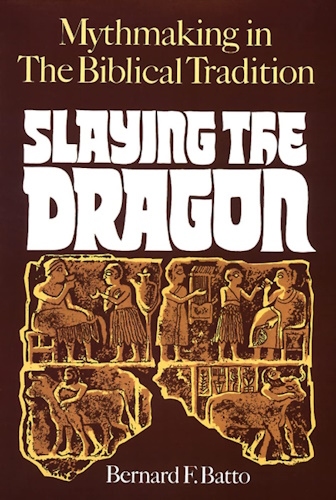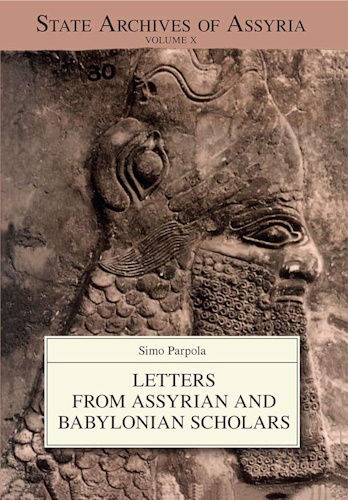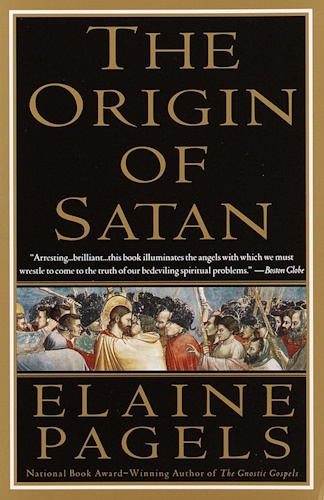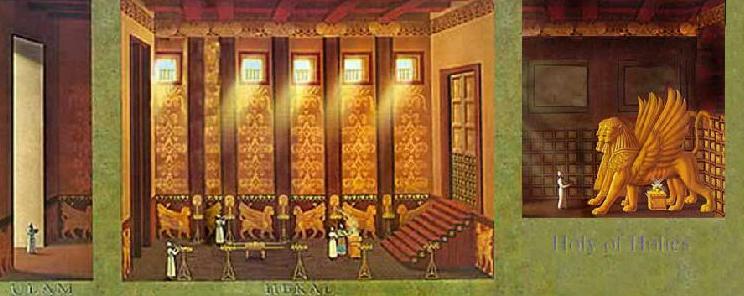![]()
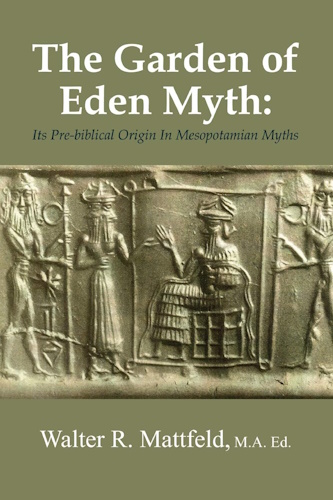
Bible Origins
Genesis' Genesis:
The Hebrew Transformation
of the
Ancient Near Eastern Myths and Their Motifs
(Primarily, the Epics of Gilgamesh and Atrahasis)
by
Walter Reinhold Warttig Mattfeld y d la Torre, M.A. Ed.
e-mail contact
25 March 2001
Revisions through: 27 October 2006
![]()
Part 2: Conclusions/Bibliography
![]()
I understand that Genesis is _denying or refuting_ the Mesopotamian myths' explanation of how and why man came to be made, what his purpose on earth is, and why his demise was sought in a flood. This "_denial_" is for me accomplished by taking motifs from a variety of contradicting myths and giving them "new twists" by changing the names of the characters, the locations, and sequences of events. It is my perception that the Hebrews are _not copying_ the Mesopotamian myths, they are deliberately CHANGING _or_ RECASTING their motifs and concepts inorder to REFUTE and DENY THEM, hence the "reason why" there are _no_ individuals called Adam, Eve, the Serpent, Yahweh, Noah, Shem, Japheth and Ham appearing in _any_ of the Mesopotamian pre-biblical myths.
If I had to summarize my research on Genesis' motifs from the Garden of Eden to the Flood vis-a-vis the Mesopotamian "creation of man" myths it would have to be that the Mesopotamians appear to have held their gods as responsible for man's misfortunes whereas the Hebrews in refuting this, held man as culpable, absolving their God of any blame. In other words the Mesopotamians saw _MAN AS THE VICTIM_ of capricious gods versus the Hebrew notion that _GOD IS THE VICTIM_ of an ungrateful and rebellious mankind.
The Mesopotamians saw the world being created for the benefit of the gods, not man. Genesis refutes this notion, God made the world for man's benefit. I understand that the Hebrews, _employing INVERSIONS_, are recasting many of the Mesopotamian motifs and concepts by 180 degrees, turning them upside down and on their ear.
![]()
14 July 2005 Update:
I understand Sumerian edin (Akkadian seru, seri), translated variously as "plain," "steppe," or "desert plain," to apply to both upper and lower Mesopotamia please click here for my article titled "Eden's Four Rivers."
21 Feb 2005 Update:
Highly reccomended is Tim Langille's article which draws pretty much the same conclusions as I do in the below article. Please click here for his article titled "Myth Making in the Bible and in the Ancient Near East: The Yahwist Primeval Creation Myth" (2003).
However, let it be acknowledged here, that in a search for "The Truth," one MUST study _both sides_, so, dear reader, I would encourage you to pause a moment and click here and read what I regard as a typical Christian Apologist "refutation" of the notion that Genesis is a reformatting of Ancient Near Eastern Mesopotamian myths.
07 March 2005 Update:
Highly reccomended is Professor William H. Shea's research (1984) comparing Genesis' Creation-Flood theme with Mesopotamian parallels, please click here for his article. Another fine article is by Professor Jeffrey Tigay, click here for his article on Paradise & the Garden of Eden.
22 March 2005 Update:
I received a most interesting e-mail today from a reader of my articles asking what my opinion was regarding the "origins" of the Anunnaki gods. I am posting my reply because it caused me "to see" the Garden of Eden story from _a neglected_ Anthropological point of view. That is to say, the Mesopotamian myths about man's origins are merely a recollection of REAL HISTORY to a degree, but in "mythologized form." I recall here Life magazine's excellent book titled The Epic of Man (Time Life Publishers. 1961), which traces his development from a naked beast, to a gatherer of nuts and berries, then hunter, who fashions clothes for himself from animal hides; then the REAL REVOLUTION, he settles down in Lower Mesoptamia and builds villages, domesticates animals, builds canals and irrigation systems and grows his food, and learns to grow plants to make "real clothes from" on looms to cover his naked body. That is to say, the Sumerian myths about the gods initially making man NAKED, and having him roam "edin-the-steppe/plain" with other animals, lapping water and eating herbs of the field with other beasts, are recalling their ancestors' evolution from hunter-gatherers to urban civilized man. It is _my understanding_ that Genesis' 1-4, although a later reformatting of these Sumerian myths is recalling this same _momentuous event_ in man's history. My letter:
"Dear XXXXXX,
I'm not quite sure how to answer your question. Obviously the Mesopotamian gods and goddesses are "figments of the imagination," and are in fact -from an Anthropological point of view- man's projection of his fears, loves and hatreds onto "imaginary" deities created in his image.
Society has always had leaders and followers, and some kind of a "pecking order" as seen in non-human species (chickens, ants, bees, wolves, apes, lions, etc). Probably the Anunnaki represent this "pecking order," they _not having to toil_ in the earthly garden of the gods, leaving the lesser Igigi gods that _onerous_ task. That is to say, in early Sumerian society there were the priests, nobles and kings who did not do manual labor, and then their were the common people, who toiled. The Anunnaki probably reflect the "privileged" class in Sumerian society and the Igigi the un-privileged.
The building of Ziggurats, called at times, Kur meaning "mountains," suggest that they may have lived originally in the Zagros mountain range as hunters and gatherers, who came down into the flood plains of the Tigris and Euphrates in search of game and wild food-bearing flora. Eventually, they came to realize they would be better-off settling down and growing their own food and raising domesticed animals of the area, and came to build at first, villages with canals and irrigation networks then cities. So the "Anunnaki stories" about them being naked at first and lapping water like beasts (like the first humans) and roaming "edin-the-plain" with wild animals, is _probably_ the Sumerian "recollection" -in mythical terms- of mankind's transformation from hunter-gatherer to agriculturalist and city dweller. In a sense, Genesis 1-9 is recalling this Sumerian mythology of man's transformation from a roaming naked beast to a clothed urbanite, but transforming it somewhat into a single god, Yahweh-Elohim vs. many gods.
I hope this has answered your question. You might also want to try the Google internet search engine for more articles on the Anunnaki."
25 March 2005 Update:
Neglected, in the above article is _"Eden from an Anthropological view"_. Let me "digress" here a moment. I was an educator or teacher from 1967 to my retirement in 2002. I taught Art and Social Studies to Middle School students (ages 12-14 years of age). One of those Social Studies courses was World Geography. Only a few days ago, did it finally dawn on me what the Garden of Eden story was "really all about." Its about something I had taught my students in Geography classes for the past 30 years!
I taught 7th Grade "Cultural Geography," man's inter-relationship to the land. The most important event in the history of mankind was when he ceased to be a roaming naked wild animal and became "civilized." This momentuous event was accomplished in the following manner: Speaking Anthropologically, man at first was an animal, he roamed naked with other beasts. He ate what they ate, wild herbs of the field and fruit from trees. He drank at watering holes with the animals. Then he became a "gatherer-hunter," still nomadic. Then the great revolution occured, man settled down, built villages and then cities, and became civilized and wore fine clothes made from plant fibers on looms. What made this "civilization" possible? It was man's becoming a domesticator of animals for food and his becoming an agriculturalist, growing and raising food to eat. In Lower Mesopotamia, he achieved this via the creation of canals and irrigation sytems for gardens supporting fruit trees, vegetables, date palms, etc., said gardens being associated with a nearby village or city.
Even today, in the 21st century, the Great Civilizations are made possible by "the agriculturalist" or farmer who tends his "garden" which provides A SURPLUS OF FOOD allowing others in the group or "society" to not have to spend their time scrounging for a mouthful to feed their empty bellies or their family's hunger. By contrast, primitive man who is still a nomadic "gatherer and hunter," spends most of his time seeking food, he has NO TIME to develop a civilization. Also note that it is not unusual to find primitive man in the wilds, NAKED like Adam and Eve, and without shame. I know of no Great Civilization, whose people wander about naked, all are clothed.
It is _my understanding_ that the Sumerian myths about the who, what, why, where, and how of man coming to be created, is in reality, recalling a REAL EVENT of great importance, these myths recall that moment in time when man ceased to be a naked wild animal roaming with other animals, and settled down, became an agriculturalist (creating gardens for food) and Civilization began.
Speaking from an Anthropological viewpoint, in reality, it was NOT a god or gods who taught man it was wrong to be naked, and provide him with clothes (as in the Sumerian Eridu Myth), nor was it the gods or a god who made man to tend his/their garden on the earth teaching him "how" to be an agriculturalist. That great achievement was man's doing, not a god's. Man gave up being a nomadic "gatherer-hunter," gave up being naked, gave up roaming the wilds with animals. In Lower Mesopotamia he settled down, built canals, irrigation ditches, became an agriculturalist, raised food, grew plants which could be turned into cloth on looms. Man, via, experimentation, keen observation of nature (flora and fauna), and trial and error, developed Civilization and cities, NOT the gods or a god.
I understand with other scholars, that Genesis' myths regarding man's creation and being placed in a god's garden to till and tend it, in a state of nakedness, and then later leaving it to found cities (Cain) is nothing more than a "re-working" of earlier Sumerian motifs on how man came to be made, and cities and civilization came into being. The Sumerians possesed one of the world's earliest "great" civilizations with temples, ziggurats, canals, cities, writing, mathematics and calendars.
The Sumerians were WRONG, the gods did NOT teach their ancestors all this ("the arts of civilization"), man achieved all this ON HIS OWN ACCORD. So, in a sense the Sumerian myths about man's creation and his cites are recalling man's _EVOLUTION_ from a naked ANIMAL TO A CLOTHES-WEARING CIVILIZED HUMAN BEING dwelling in cities.
Thus _I understand_ Genesis' "Garden of Eden" and creation of man by God, although a later re-working of Sumerian creation myths of how mankind came to be made by the gods, is in reality, a recollection of the greatest achivement ever made by man, his self-transformation from a wandering naked animal to a settled agriculturalist and city dweller, all made possible by man's becoming an agriculturalist, creating wonderous gardens capable of creating a "food-surplus" freeing his fellow men, so that they could apply themselves to discovering and developing the "arts of civilization."
So, man _was robbed_ by "priests" of his greatest intellectual achievement, his SELF-TRANSFORMATION from a naked animal roaming edin-the-plain to a clothes-wearing civilized man. The "priests" of Sumer ascribed man's "wearing of clothes" and "arts of civilization" to the gods teaching man that he should wear clothes, till and tend gardens and build cities. It would take some 6000 years for man's SELF-TRANSFORMATION from naked beast to clothes-wearing city-dweller to be _properly restored to man_ by the Secular Humanist disciplines of Archaeology and Anthropology, which arose in the course of the late 19th and 20th centuries, our modern era.
This article is an attempt to briefly identify some of the Ancient Near Eastern Motifs and Myths which the Hebrews apparently borrowed, adapted, and reworked in the Book of Genesis. It is my understanding that the Mesopotamian Epics of Gilgamesh and Atrahasis constitute MAJOR sources for various motifs and concepts appearing in Genesis 1-9 (the Creation to the Flood), however other sources are the Adapa myth, Inanna and Utu, the Enuma Elish, etc.
Professor Blenkinsopp (of Notre Dame University) on Atrahasis and Gilgamesh motifs in Genesis:
"...just as Genesis 1-11 as a whole corresponds to the structure of the Atrahasis myth, so the garden of Eden story has incorporated many of the themes of the great Gilgamesh poem."
(pp. 65-6. "Human Origins, Genesis 1:1-11:26." Joseph Blenkinsopp. The Pentateuch, An Introduction to the First Five Books of the Bible. New York. Doubleday. 1992. ISBN 0-385-41207-X)
Professor Foster on the Mesopotamian literary audience:
"To a Mesopotamian audience, certain themes of the poem [The Epic of Gilgamesh] would have been familiar from other popular literary works. The portrayal of human mortality as a consequence of divine selfishness, for example, was well known to them. They also recognized a hero as a man striving towards greater accomplishments than those of ordinary people, in spite of the limitations imposed by chance and destiny. The Mesopotamians preferred literary works set in ancient times, involving kings and gods, narrating events largely outside of everyday experience. Yet the divine and human heroes often display imperfections and personal limitations, as if the remoteness of time and empirical background were no obstacles to projecting inglorious human weakness onto long-ago heroes. The theme of the partiality of divine justice was familiar to Babylonian readers as well: they would not have been surprised at the unfair condemnation of Enkidu nor at the intervention of the sun god, Shamash, to the crucial advantage of the heroes...Mesopotamians expected their literature to stress the importance of knowledge. The significance of Gilgamesh's story lay not so much in the deeds themselves as in the lesson his experience offered to future generations. The Mesopotamians believed that the highest knowledge came to sages of the remote past directly from the gods or through extraordinary events not likely to recur. For their own times, they thought that the highest knowledge came from the study of written works of the past."
(pp. xx-xxi. "Introduction." Benjamin R. Foster. The Epic of Gilgamesh. [Norton Critical Edition]. New York. W. W. Norton & Company. 2001. ISBN 0-393-97516-9 paperback)
Foster's observation that Divine and Human Heroes being portrayed with human weaknesses, would appear to belie that oft heard claim by some Bible Fundamentalists, that the Bible really is the word of God because it shows heroes like David and Solomon with human character flaws. These flaws appear to be following in the Mesopotamian tradition. A number of scholars have noted God's character flaws, his anger, vacillation, vindictiveness, lying, contradicting himself, persecuting the faithful as well as the sinner- all in harmony with the earlier Mesopotamian notions of the Gods possessing the same human weaknesses !
Professor Hooke on Genesis' Myths:
"The mythological material was specifically affected by this process; hence three main problems confront us in studying the mythology of the Old Testament. First we have to inquire what was the source and original form of the myths which we find there; then what modifications did the Hebrew writers or editors make in the mythological material which they borrowed from Canaanite or other sources; and lastly whether Israel produced any myths of its own.
The final editors of the Old Testament collected most of the mythological material into the first eleven chapters of Genesis but other myths and legends are to be found in fragmentary form scattered through the sagas and poetry of Israel..."
(pp. 104-105. S. H. Hooke. Middle Eastern Mythology. Penguin Books. Harmondsworth, Middlesex, England. 1966, 1981 [paperback]. Note: The late Samuel Henry Hooke, 1874-1968, was Professor Emeritus of Oriental Languages at Toronto University)
Rogerson understands Genesis was composed in the Exile or shortly thereafter, I understand it was composed in 560 BCE (Emphasis mine):
"The simple answer to the question of date is that Genesis 1-11 is _part of the larger work_ containing Genesis to 2 Kings...This COMPLETE WORK did not reach its final form until during or after the Babylonian Exile in the sixth century BCE. However, the date of the final editing does not determine the date of the individual items to be found in Genesis 1-11."
(p. 76. "The Date of Genesis 1-11." J. Rogerson. Genesis 1-11. Sheffield, England. JSOT Press [University of Sheffield]. 1991)
It is my understanding that Genesis' motifs and characters, God, Adam, Eve, the Serpent, and Noah, are adaptations and transformations of characters and events occurring in earlier Near Eastern Myths. In some cases several characters and motifs from different myths have been brought together and amalgamated into Genesis' stories.
Lambert, has made a very important observation regarding the manner in which Mesopotamian mythographers worked:
"The authors of ancient cosmologies were essentially compilers. Their originality was expressed in new combinations of old themes, and in new twists to old ideas."
(p.107, W.G. Lambert, "A New Look at the Babylonian Background of Genesis," [1965], in Richard S. Hess & David T. Tsumra, Editors, I Studied Inscriptions From Before the Flood. Winona Lake, Indiana, Eisenbrauns, 1994)
I believe Lambert's observation can be applied to the Hebrews who were combining old themes and putting "new twists" to old ideas. My research indicates that, at times,"reversals" or "inversions"are occurring in the Hebrew transformation and reinterpetation of the Mesopotamian myths. These "reversals," as I call them, can take the form of different characters, different locations for the settings of the stories, and different morals being drawn about the nature of God and Man's relationship.
Another scholar, Wenham, made another important observation about Genesis, it is apparently a polemic, challenging the Mesopotamian view of the relationship between God and Man:
"Viewed with respect to its negatives, Gen 1:1-2:3 is a polemic against the mythico-religious concepts of the ancient Orient...The concept of man here is markedly different from standard Near Eastern mythology: man was not created as the lackey of the gods to keep them supplied with food; he was God's representative and ruler on earth, endowed by his creator with an abundant supply of food and expected to rest every seventh day from his labors. Finally, the seventh day is not a day of ill omen as in Mesopotamia, but a day of blessing and sanctity on which normal work is laid aside. In contradicting the usual ideas of its time, Gen 1 is also setting out a positive alternative. It offers a picture of God, the world, and man...man's true nature. He is the apex of the created order: the whole narrative moves toward the creation of man. Everything is made for man's benefit..."
(p. 37, Vol. 1, "Explanation," Gordon J. Wenham, Genesis 1-15 [Word Biblical Commentary, 2 vols.], Word Books, Waco, Texas 1987, ISBN 0-8499-0200-2)
Lambert's and Wenham's observations are "keys" to understanding how and why Genesis was formatted in the manner it now appears. In other articles posted on this website I have explained why I believe that Genesis was composed in the Exilic era (ca. 560 BCE), I accordingly understand that the Ancient Near Eastern myths and their motifs being utilized by Genesis' author, are of periods preceeding 560 BCE.
Numerous scholars have noted that some motifs appearing in Genesis can be found in Sumerian myths of the 3rd millenium BCE. Kramer, a Sumeriologist, makes the following observation:
"Sumerian literature contained a number of literary forms and themes found much later in the Bible...there are many parallels to Sumerian literature in biblical themes."
(p.154, "Sumerian Literature and the Bible." Samuel Noah Kramer and John Maier. Myths of Enki, the Crafty God. New York. Oxford University Press. 1989. ISBN 0-19-505502-0)
Professor Tigay, noting that some scholars _deny_ any "borrowing" of Mesopotamian motifs for the book of Genesis because details _differ_ between the biblical and Mesopotamian accounts of the Flood, concluded that the Bible has "indeed" borrowed from Mesopotamian motifs and transformed them (Emphasis mine):
"This brief survey shows that peripheral versions of Mesopotamian literary texts may not only differ from the Mesopotamian versions in detail, but that they may abbreviate them or even modify them in accordance with their own ideology and local interests, PRECISELY AS THE BIBLE APPEARS TO HAVE DONE. If these data appear to weaken the grounds for opposing claims of literary borrowing -- and I believe that they do -- then this has some unsettling implications. For it means that an alleged relationship between a Biblical text or motif and some ancient Near Eastern counterpart CANNOT BE REFUTED SIMPLY BY POINTING TO DIFFERENCES BETWEEN THE TWO, even if they are numerous."
(for the in-depth arguments cf. Jeffrey H. Tigay. "On Evaluating Claims of Literary Borrowing." University of Pennsylvania. http://ccat.sas.upenn.edu/jwst/borrow.htm )
My research suggests that motifs from Canaan, Phoenicia, Syria, and Mesopotamia are being drawn from.
Genesis opens with a world in existance, but covered in water, called in Hebrew, Tehom (English: "the deep" Ge 1:2). Mesopotamian myths have the world originating in a watery deep, a saltwater ocean called Tiamat; some have sought Hebrew Tehom as a cognate of Tiamat. Tiamat was personified as a goddess, and the mother of the gods. Her husband was called Abzu/Apsu, the freshwater ocean which lies under the earth when it arose from the sea. The mingling of Apsu and Tiamat created the gods who in turn eventually created man.
In Genesis God speaks and things are created, light from the sun, moon and stars, land arises from Tehom, herbage is created, animals, and finally man. Kramer has noted that the Sumerians possessed the idea that the gods could speak and things would be created. They also are portrayed as forming things with their hands, like man, just as God "makes" Adam from the dust of the earth-
"Some of the more conspicuous themes involve creation of the universe, creation of humankind, techniques of creation (in two ways, by word and by 'making' or 'fashioning')..." (p.154, Kramer)
In the Enuma Elish (a Babylonian myth), Marduk, the supreme god of Babylon, is portrayed slaying Tiamat and making the earth, rivers and heavens from her body. From her pierced eyes arise the Tigris and Euphrates rivers. Perhaps this is why the Hebrews called the fresh waters under the earth as well as the salty ocean, Tehom (cf. Ge 1:2 Tehom or "the deep" being the waters covering the whole earth, and Ezek 31:4-9, where "the deep," or subteranean streams, nourishes trees in the Garden of Eden).
God makes a world in six days and then rests on the seventh, hallowing it, and it becomes known as the Sabbath (Hebrew: Shabbat). He creates a Garden of Eden and places a man in it, and later introduces a woman for a companion (made of man's rib). I have argued elsewhere that Genesis' author is borrowing motifs about the Sumerian paradise called Dilmun and transforming the story (cf. my article, Sabbath Origins and the Epic of Gilgamesh).
Clifford appears to understand that some motifs in Genesis' Garden of Eden account are drawing from earlier Mesopotamian works. He specifically identifies Atrahasis and Gilgamesh and the Sumerian Pre-flood list of kings and suggests that the serpent appearing in the Epic of Gilgamesh has been recast as Eden's serpent:
"Were Adam and Eve created immortal only to lose it in the sentence imposed on them in 12:17, "on the day you eat [the fruit] you shall die"? The question is difficult to answer. For one thing, Genesis 2-11 drew on more traditions than Atrahasis and Gilgamesh. The ten preflood ancestors of Noah seem derived from the ten kings found in some versions of the Sumerian King List...The question of Adam's mortality must ultimately, of course, be decided from Genesis and not its sources...The J-storyteller [Yahwist author] takes the Gilgamesh motif of the snake's theft of the plant of life from the hero (a postflood occurrence in Gilgamesh XI) and places it before the flood (Genesis 3). As in Gilgamesh, Adam is naked when the loss takes place, the snake deceitfully steals the fruit supposed to transform life, and a tree or plant of life is involved. Such kaleidoscopic reuse of traditional details may seem strange to modern readers, but ancient authors evidently liked to put familiar objects in new contexts...Another example comes from Gilgamesh I: the naked and animal-like Enkidu acquires wisdom from his seven-day dalliance with a prostitute. Afterwards she clothes him and leads him to the city of Uruk and its king Gilgamesh. Genesis rearranges the same traditions to describe the institution of marriage!"
(pp. 147-149. "Genesis 1-11." Richard J. Clifford. Creation Accounts in the Ancient Near East and in the Bible. Washington, DC. The Catholic Biblical Association of America. The Catholic Biblical Quarterly Monograph Series No. 26. 1994. ISBN 0-915170-25-6)
Eden is said to lie somewhere "in the East." We are also informed that Haran of Mesopotamia was in the East (Ge 29:1). I have proposed that Dilmun lies in Mesopotamia, so apparently, Mesopotamia is conceived of as being "in the East."
My research on Eden has caused me to realize that the _ORIGINAL PRE-BIBLICAL SOURCES_ of "the garden of Eden" are _several locations_ as preseved in various Mesopotamian myths.
I found these Edens, as a "byproduct" of attempting to document Mesopotamian _parallels_ to the Adam and Eve story in the Bible, as noted in the scholarly literature. To my surprise, I discovered that no single Mesopotamian myth possessed _all_ the elements or motifs appearing in the biblical story. The parallels or motifs were "scattered" amongst several different myths. Another unexpected surprise was to realize that the Mesopotamian myths at times DISAGREED and CONTRADICTED each other about how man came to be made by the gods and WHERE the location of his first appearance on the earth was. I understand that the Hebrews brought these contradicting parallels or motifs together and created the garden of Eden myth from them.
1) According to the Bible man is made by God and placed in the garden of Eden to till and keep the garden. Some Mesopotamian myths understand that man was created to till and tend the earthly garden at Nippur belonging to a god who in myth is called Enlil. The products of this garden were originally tended and tilled by the Igigi gods, who objected to the working conditions. To prevent a revolt by the Igigi, man is made by the god Enki to replace them at Enlil's behest. Enki has an Igigi god slain and his flesh and blood are mixed into some clay making man. So, both Mesopotamia and the Bible understand man's _first appearance_ on the earth is in a garden belonging to _a_ god_, his job being to tend and till it. However, in Sumer, the god's garden is ALWAYS associated with a city that the god dwells in. The Mesopotamian "garden of the god" was NOT in some remote wilderness all by its self as portrayed in Genesis. So, Nippur's _garden of a god_ (Enlil), is an edenic prototype.
2) In another contradicting myth, man is created by the god Enki to tend and till _his_ garden located in the city of Eridu in Sumer. The Igigi gods at Eridu object to their hard toil in Enki's garden so he makes man to replace them. In this myth man is made of clay over the apsu (a freshwater source of all rivers, a spring). Please note that Eridu like Nippur, lies on a great plain or steppe, which in Sumerian is called edin and in Akkadian seru or seri. So, man is made at Eridu _in_ edin, of its clay or earth, thus Eridu and vicinity is another edenic prototype. The Sumerians never called the gods' city-gardens edin. The _uncultivated_ land (steppeland or plain) contiguous to, surrounding, and about the cities and their city-gardens was the edin. The Sumerians distinguished two edins, an-edin "high plain" or "high steppe," and ki-edin "low plain" or "low steppe." Unknown to many, except professional Assyriologists, is that the Akkadian word seru or seri meaning uncultivated "plain" or "steppe" is COMMONLY rendered by the use of a Sumerian logogram or cuneiform sign rendered in English in capital letters within ellipses as (EDIN). For example, the Epic of Gilgamesh describes Shamhat's encounter at the watering hole in the seru where apears Enkidu with the gazelles as he being a wild man of (EDIN). That is to say, the Sumerian edin logogram was in the mind of the Akkadian scribe (who knew Sumerian) equated with the Akkadian word seru or seri. I understand Enkidu and Shamhat have been recast as Adam and Eve and the watering hole of (EDIN) has been recast as the garden in Eden.
3) Another CONTRADICTING Mesopotamian myth, called by some scholars "The Eridu Genesis Myth" has man in a steppe or plain called in Sumerian edin and in Akkadian (Babylonian) seru. He wanders this edin NAKED and wild animals are his companions; he eats grass and laps water at watering holes like an animal. Eventually a goddess called Nintur takes pity on naked man's "hard life" in edin the steppe and takes him from this edin and "civilizes him." Man is taught that it is wrong to be naked, he MUST wear clothes when he comes to _dwell with the gods in their cities_ and _work in their gardens_, for the gods wear clothes and nakedness is an offense for them. The gods provide man clothing and settle him in cities built originally to house only the gods. From the gods man learns the arts of civilization, how to make musical instruments, how to forge metals, how to be shepherds, how to grow food in irrigation-fed gardens, as the gods do. To the degree that edin means a "plain, floodplain or steppe", and the Tigris and Euphrates do cross a great _plain_, extending from Baghdad to Basrah these rivers are thus associated with edin. However, please note an interesting contradiction exists here, the cities of Sumer were built in edin the plain. According to one myth in the beginning the gods (called the Annunaki) who built these cities were originally naked like animals, eating grass and lapping water like naked man. So, edin is not only the UNTAMED PLAIN that wild animals and naked man roamed, its also a plain "TAMED" by civilized man, with irrigation canals and networks for gardens and cities! So, edin the UNTAMED PLAIN which lies _near_ Nippur and Eridu as well as Uruk (biblical Erech Genesis 10:10) is another edenic prototype. The Eridu Genesis myth notes that NAKED man in the UNTAMED edin knew NO FEAR, no animal offered harm to him. Harm came when man left this edin to dwell in cities and maintain the gardens of the gods in Sumer. Apparently Genesis' notion of an "idyllic eden" is fusing two different Mesopotamian concepts, the UNTAMED edin with the TAMED edin which has cities, canals and irrigated gardens planted by the gods for their self-nourishment.
4) The notion that Adam and Eve ate of forbidden food from a tree is drawn from -in part- the myth about Enki and Ninhursag in the earthly garden of Dilmun. Enki eats without his goddess-wife's permission eight of her plants, in order to "know" them; enraged, she curses him with death, the first plant that Enki consumed is called "a tree plant". She later relents, asking him what body part ails him and thereupon makes either a god or goddess to heal that part. When he complains of his rib aching, she makes Nin-Ti, a goddess to heal his rib (Sumerian ti means rib). In Sumerian Nin-ti can mean "Lady of the rib" and "Lady that makes live." One of Enki's epithets was En-Ti, "Lord of the Rib."A number of professional scholars have suggested that Eve's being made of Adam's rib is drawing from this myth, as well as her name Eve, Hebrew Havvah meaning "mother of life" located at Dilmun. Some scholars have suggested Dilmun is the island of Bahrain near Saudi Arabia in the Persian Gulf. My research, however, suggests its Tell el Lahm east of Eridu. The Mesopotamian Noah called Ziusudra was placed in Dilmun, " _in the East_ where the sun rises, _AT THE MOUTH OF THE RIVERS_".
Kramer suggested Dilmun was an Edenic prototype (Note: I understand the "Sumerian Noah and wife place in Dilmun to be prototypes for Adam and Eve):
"Paradise, according to the Sumerian theologians, was for the immortal gods, and for them alone, not for mortal man. One mortal, however, and only one, according to Sumerian mythmakers, did suceed in gaining admittance to this divine paradise. This brings us to the Sumerian "Noah" and the deluge myth, the closest and most striking Biblical parallel as yet uncovered in cuneiform literature."
(p. 149. "The First Biblical Parallels." Samuel Noah Kramer. History Begins At Sumer: Twenty-seven "Firsts" in Man's Recorded History. Garden City, New York. Doubleday Anchor Books. 1959 reprint of 1956 published by The Falcon's Wing Press)
But, according to other non-mythcal annalistic texts, Dilmun is a location with a city, it has a king, buildings, boat docks along a river which lies in a marshland setting, irrigation canals, plantations of Date Palms, lagoons filled with fish. So, Dilmun/Tilmun (Tell el Lahm), in the marshes east of Eridu, Shuruppak and Uruk, is another edenic prototype.
5) The motif of forbidden access to trees appears in the Epic of Gilgamesh, when he and Enkidu set out to cut down for timber Cedars growing on a mountain guarded by a half-human monster called Huwawa or Humbaba. Most scholars usually identify this cedar mountain with some location in the Lebanon, famed in antiquity for its mighty cedars, coveted for the building of palaces and temples throughout the Ancient Middle Eastern world. Gilgamesh and Enkidu take 6 days to cross a great plain (also called the steppe, Akkadian seru or Sumerian edin) to reach this cedar mountain where Enkidu once roamed with his animal friends. Has Huwawa the guardian of the trees been reformatted in the Cherubbim? Has the SWORD used by Gilgamesh to slay Huwawa become the "feiry sword" that bars access to the forbidden trees of Eden? Perhaps Adam and Eve's forbidden access to sacred trees is a reformatting of Gilgamesh and Enkidu's forbidden access to cedar trees? If so, then it worth noting that Ezekiel mentions the cedars of Lebanon in the Garden of Eden, comparing themselves to Pharaoh who is portrayed like a mighty cedar. That is to say, perhaps a Lebanese cedar mountain in the Epic of Gilgamesh lies behind Ezekiel's imagery of a cedar mountain in the Garden of Eden in the Lebanon? Thus another "edenic prototype" is a Lebanese cedar mountain.
Ezekiel 31: 3, 8-9 RSV
"Behold, I will liken you [Pharaoh] to A CEDAR IN LEBANON...THE CEDARS in the GARDEN OF GOD could not rival it...all the trees of EDEN envied it, that were in the GARDEN OF GOD."
Some may "wonder" how does the garden of Eden wind up in association with a _mountain_ (Hebrew: Har, pronounced khar) in Ezekiel's imagery if it originally was associated with Sumerian edin-the-PLAIN? The answer will surprise you! In Sumerian hymns, Eridu in Sumer, where Enki lives, and where he "made man to tend and till his fruit-tree garden" is called on occasion, _KUR_, which in Sumerian has several meanings: "land", "the underworld," and "_MOUNTAIN_." Perhaps "_KUR_ERIDU_" became over the millennia, the "Garden of Eden on a mountain"? Another contradicting myth as noted above, has man created at Nippur to tend the garden of a god called Enlil. Enlil dwelt in a temple-ziggurat called e-kur, meaning "mountain house" (e= house, kur= mountain), so his garden is associated with a mountain too like Eridu.
Kramer (emphasis mine in CAPITALS):
"Then Enki raises the city Eridu from the abyss and makes it float over the water like a lofty MOUNTAIN. Its green fruit-bearing gardens he fills with birds...
Enlil says to the Anunnaki:
"Ye great gods who are standing about,
My son has built a house, king Enki;
Eridu LIKE A MOUNTAIN, he has raised up from the earth,
In a good place he has built it."
(pp. 62-63. "Enki and Eridu: The Journey of the Water-god to Nippur." Samuel Noah Kramer. Sumerian Mythology: A Study of Spiritual and Literary Achievement in the Third Millennium B. C. Philadelphia. University of Pennsylvania Press. 1944, 1961, 1972, 1997. ISBN 0-8122-1047-6 paperback)
Now, Eridu does have the remains of a great ziggurat-temple , and the ziggurat at Nippur was called the E-Kur "Mountain House" of the god Enlil. So, if one wants to argue for the real physical presence of a "mountain" at Eridu in association with Enki's fruit-tree garden worked by man who has been created to replace the Igigi gods, the ziggurat would be my first choice. The other possible "edenic mountain" is Nippur's ziggurat called the "mountain house" where man was created to work in a god's garden (Enlil's garden).
6) Adam loses out on attaining immortality, he ate the forbidden fruit. This motif appears in several Mesopotamian myths. In the Adapa myth (Adam's prototype according to several scholars) while at Eridu, his god Enki warns him that when he goes up to heaven to face the supreme god An or Anu, not to eat anything offered for its is "the food of death." In reality, it is the "food conferring immortality" on mankind, but Enki does not want to lose man as a servant (He made man to be a servant to the gods). The Hebrews have INVERTED this myth, having man consume forbidden food when in the Adapa myth man obeyed a lying god and lost out in attaining immortality (but note, neither Adapa or Adam ate the food which would confer immortality on them and via them, mankind). In another INVERSION the Hebrews place the event on the earth (but note that the warning from Enki was given on the earth at Eridu, which lies in edin-the-plain, where he has a garden of fruit trees he planted next to his shrine). So, another "edenic prototype" is Anu's abode _in Heaven_.
7) By the 2d-1st centuries BCE (Before the Common Era or BC, Before Christ), the Hasmonean Jews had come to locate Eden in the Yemen and nearby Dhofar, sources of spices and incense since King Solomon's days and the Queen of Sheba. This notion is preserved in various books called "The Pseudepigrapha." These books claim that when Adam was expelled from Eden, he asked God to allow him to take from the garden, spices and incense as offerings to God, and God assented. As the ONLY known location for these products was Southwest Arabia (the Yemen and Dhofar), thus Eden came to be "transposed" there from Lower Mesopotamia (the steppe called edin, where are located Eridu and Nippur of Sumer as well as Dilmun and its marshes) to a new location. Jewish communities, according to Yemeni Jewish traditions existed from Mecca and Medina to the Yemen, settled in the days of Solomon and the Queen of Sheba, to exploit the spice trade between Sheba and Jerusalem (other traditions say they settled in the area after the fall of Jerusalem, ca. 587 BCE, to the Babylonians). So, by the 2d-1st centuries BCE, Eden had come to be identified with Arabic Adn, the modern port of Aden in the Yemen, the Islamic holy book, The Koran/Quran, calls the "garden of Eden" Jannat Adn. Thus, when The Quran came to be composed in the 7th century CE (CE means "of the Common Era", or AD meaning Anno Domini, "year of our Lord"), its Jannat Adn (however Jannat Adn in the Quran is understood to be in heaven, not on the earth), was a concept the Arabs had picked up from Jews living in their area, which had been a part of Jewish folklore since the 2d century BCE; that is to say, for some 9 centuries Jewish traditions in the areas of the Yemen, Mecca and Medina, had preserved a notion of Eden being in this part of the Arabic world!
8) Even later, additional Pseudepigraphic writings identified Eden with Jerusalem or Bethshean near the Jordan River!
9) Today, some scholars seek Eden in Missouri (the Mormons), others near the headwaters of the Tigris and Euphrates ( David Rohl ). Another scholar, Dr. Juris Zarins proposed that Eden is submerged beneath the Persian Gulf near the mouth of the Shatt al-Arab in Iraq. By the 1600's and 1700s a number of European scholars, both Catholic and Protestant, believed Eden could never be found because they argued that Noah's Flood had destroyed the original river courses by which it could be pin-pointed or located.
I do NOT understand that Eden is a real place, _its a Hebrew myth_ based on a re-working of earlier Mesopotamian myths, which offer -contradictorily- several different locations, as noted above.
The original pre-biblical prototypes appear to be_all_ Mesopotamian and associated with the great plain of edin in LOWER MESOPTAMIA and the lands of Sumer, Dilmun, and a Lebanese Cedar Mountain abutting edin-the-plain.
Of interest here, is a Mesopotamian flood myth in which Enlil is portrayed as the principal instigator in SENDING a flood to destroy _all_ of mankind which disturbs _his rest_ with its noise. However, his brother, the god Enki, "defies him" and WARNS a pious man called variously Ziusudra, Atrahasis or Utnapishtim of the coming flood and to save himself, family and animals by building a boat. When the flood ends an enraged Enlil learns that some humans have survived (Ziusudra and family). Enki confronts his angry brother beseeching him not to ever again send a flood to destroy mankind. Enlil relents and agrees never again to send a flood then Enlil "blesses" the survivors (Yahweh "blessed" the flood's survivors too, cf. Ge 9:1).
In Genesis it is Yahweh who SENT the flood and he WARNED one man, Noah, to save himself, family and animals by building a boat. I understand that Yahweh-Elohim is a fusion of Enlil who _sent_ the flood and Enki who _warned_ the Mesopotamian Noah, Ziusudra and his family.
So, according to various Mesopotamian "creation and flood" myths man was created to tend and till the garden of _a_ god in edin-the-plain at Nippur (Enlil) and another contradicting myth has man created to work in a garden of _a_ god in edin-the-plain at Eridu belonging to Enki. Thus the two brother gods, Enlil and Enki, who each had man created to work in their garden located in edin, are also involved in a Mesopotamian FLOOD myth, the one seeking mankinds' destruction, the other intervening to spare "a remnant" for a new beginning. That is to say, I understand that Enlil and Enki "lurk" behind Genesis' presentation of Yahweh-Elohim.
Another important "theme" or "motif" in the Mesopotamian "creation and flood" myths is that of the gods' attaining REST. Man is made to replace the Igigi gods who toil in the garden of a god (Enlil) at Nippur or at Eridu (Enki). The Igigi thus attain "eternal rest" from agricultural toil with man's creation. In the Mesopotamian flood myth man is to be destroyed because his "noise" disturbs the "rest" of the god Enlil (for whom man was created to work in his garden at Nippur) who complains he can neither sleep or rest! The myths suggest that the Igigi themselves constantly clamored for a freedom from toil and this clamor was at first ignored by the Annuaki or senior gods (Enki and Enlil). When man is made, we are told that the Igigi gods "clamor" is TRANSFERRED to man! In other words, the reason for man's "clamor" is for the same reason as that of the Igigi gods' -he has no rest from agricultural toil! Enlil decides he will obtain sleep and rest from the "clamor" by sending a flood to destroy man. That mankind seeks to enter into the "rest" from toil enjoyed exclusively by the gods is suggested in the Bible when Yahweh swears he will not allow a sinful mankind to enter into "his rest" (cf. Hebrews 3:11, 18; 4:1, 3, 5, 8-11).
Professor Foster:
"When the gods were man, they did forced labor, they bore drudgery. Great indeed was the drudgery of the gods, the forced labor was heavy, the misery too much: The seven (?) great Anunna-gods were burdening the Igigi gods with forced labor...[The gods] were digging watercourses, canals they opened, the life of the land...They heaped all the mountains. [ years] of drudgery, [ ] the vast marsh. They counted years of drudgery, [ and] forty years too much ! [ ] forced labor they bore night and day. They were complaining, denouncing, muttering down in the ditch, "Let us face up to our foreman the prefect, He must take off this our heavy burden upon us!"
(pp. 52-3, "The Story of the Flood," [The Atrahasis version]." Benjamin R. Foster. From Distant Days, Myths Tales and Poetry of Ancient Mesopotamia. Bethesda, Maryland, CDL Press, 1995, ISBN 1-883053-09-9, paperback)
The Anunna gods acknowledge the burden of the Igigi and their "clamor":
"Ea made ready to speak, and said to the gods [his brethren], what calumny do we lay to their charge? Their forced labor was heavy. [their misery too much]! Every day [ ] the outcry [was loud, we could hear the clamor]. There is [ ] [Belet-ti, the mid-wife], is present. Let her create, then a human, a man, let him bear the yoke...[let man assume the drud]gery of god...She summoned the Anunna, the great gods...Mami made ready to speak, and said to the great gods, "You ordered me the task and I have completed (it)! You have slaughtered the god, along with his inspiration. I have done away with your heavy forced labor, I have imposed your drudgery on man. You bestowed (?) clamor upon mankind..."
(pp.58-59, Foster)
The Igigi gods in gratitude fall at her feet, kissing them, she having freed them from toil, and declare a new name for her "Mistress of All the gods" (Belet-kala-ili).
A CAVEAT ("WARNING"):
As can be seen from Professor Foster's above translation the Igigi gods are objecting to the making of watercourses and canals, NOWHERE does the text say they are working in the Anunnaki gods' city-gardens! So, why am I claiming the Igigi worked in the Anunnaki gods' gardens?
I am stepping back and looking at the "big picture," or to put it another way "connecting the dots" (making INFERENCES)! We have two sets of gods dwelling in cities they have made for themseleves on the earth, the senior gods called the Anunnaki or Anunna and the junior gods called the Igigi. The Anunnaki are making the Igigi do the work. What is the purpose of canals and watercourses in Mesopotamia? Its not to water the grass lawns near the temples. The cities of Lower Mesopotamia are habitable only if a food-supply is available for the occupants.
The watercourses, canals and irrigation ditches MAKE POSSIBLE THE CITY-GARDENS OF THE GODS. Thus I INFER that when the Anunnaki sit down to a meal, they as the senior gods are not out in the hot sun planting the crops, nor are they hoeing out the weeds, nor are they harvesting the crops, nor are they preparing the crops for the table. The Anunnaki are eating the garden-produce, and someone has to make all this "happen."
According to the myths Man has not yet been created, so that leaves the Igigi gods as bearing these burdens. That is to say it is my understanding that they not only are digging-out watercourses and canals, but irrigation ditches, and planting, hoeing and harvesting the crops to feed the Anunnaki as well as themselves.
When it is at last decided to REPLACE THE IGIGI WITH MAN, it is man who will now dig watercourses, canals, irrigation ditches and plant the crops, hoe them of weeds and harvest them and present them as food in the temples and shrines to the Anunnaki and the Igigi. Hence the reason I understand that the Igigi were burdened with toil in the gods' gardens. The gods' gardens cannot exist without water from man-made watercourses, canals and irrigation ditches.
George (a Professor of Babylonian at the University of London's School of Oriental and African Studies) suggests that THE IGIGI WERE TASKED WITH GARDENING DUTIES: planting, harvesting and preparing crops for the table in addition to making canals and irrigation ditches (Emphasis mine):
"We know from many ancient Mesopotamian sources, in Sumerian and in Akkadian, that the Babylonians believed the purpose of the human race to be the service of the gods. BEFORE MANKIND'S CREATION, the myth tells us, the cities of lower Mesopotamia were inhabited by the gods alone and they had to feed and clothe themselves by their own efforts. Under the supervision of Enlil, the lord of the earth, THE LESSER DEITIES GREW AND HARVESTED THE GODS' FOOD, TILLED THE SOIL and most exhaustingly, dug the rivers and waterways THAT IRRIGATED THE FIELDS...Eventually the labour became too much for them and they mutinied." (p. xxxvii. "Introduction." Andrew George. The Epic of Gilgamesh. The Babylonian Epic Poem and Other Texts in Akkadian and Sumerian. London. Penguin Books. 1999)
I understand that the "irrigated fields" ARE THE CITY GARDENS OF THE GODS, which provide them with food. Man is created to replace the mutinous Igigi gods. Man's destiny is to toil in the Gods' gardens for evermore, providing the Anunna and Igigi gods with food, releasing them from agricultural toil upon the earth. Genesis' notion that God made man and placed him in his garden in Eden, is then, for me a later Hebrew recasting of the Mesopotamian myths about man being made and placed in the gods' gardens to relieve them of toil. The Hebrews in RECASTING these Mesopotamian myths regarding how, why, when, where man was created ARE REFUTING, DENYING AND CHALLENGING this presentation of the relationship between Man and his God.
Man is made of clay at Nippur under the god Ea's (Sumerian Enki) direction. This clay is given life or animated by being mixed with the flesh and blood of the Igigi god considered to be the ringleader of the Igigi rebellion against Enlil of Nippur. That is to say Man's REBELLIOUSNESS to a god is because he has in his body the REBELLIOUS SPIRIT of the slain Igigi god. The Hebrews are REFUTING this notion, portraying Adam as REBELLING against Eden's God as an act of freewill, by eating the forbidden fruit. For the Mesopotamians MAN IS THE VICTIM OF THE GODS. For the Hebrews GOD IS THE VICTIM of a rebellious ungrateful mankind whom he wishes to shower with love and fellowship.
How did the Hebrews come by these ORIGINALLY SUMERIAN MOTIFS? The answer is that these existed in the literature and traditions of a city called UR OF THE CHALDEES where lived Terah and his son Abraham. I understand that these two individuals, transformed these myths, believing that they had a "relevation from God," to do so.
Predictably the local populace OBJECTED to this reinterpretation and transformation of their myths explaining where, how and why man came to be made. I suspect Terah and Abraham left Ur of the Chaldees as OUTCASTS or HERETICS, rejected by the local populace. Of note here is that the Jewish Hasmonean authors of the book of Judith (said book being in Catholic Bibles, and a few Protestant bibles under the title of Apocrypha), understood that because Terah and Abraham had REJECTED THE GODS OF THEIR ANCESTORS, to follow Yahweh-Elohim, they were _forced to flee_ to Haran of Mesopotamia, and later to Canaan.
Here is the account from Judith (believed by some scholars to date from the late 2nd century BCE):
Judith 5:5-9
"Then Achior, the leader of all the Ammonites, said to him, "Let my lord now hear a word from the mouth of your servant, and I will tell you the truth about this people that dwells in the nearby mountain district. No falsehood shall come from your servant's mouth. This people is descended from the Chaldeans.At one time they lived in Mesopotamia, because they would not follow the the gods of their fathers who were in Chaldea. For they had left the ways of their ancestors, and they worshipped the God of Heaven, the God they had come to know; hence they drove them out from the presence of their gods; and they fled to Mesopotamia, and lived there a long time. Then their God commanded them to leave the place were they were living and go to the land of Canaan. There they settled, and prospered..."
(Herbert G. May & Bruce M. Metzger. Editors. The New Oxford Annotated Bible with the Apocrypha. [Revised Standard Version]. New York. Oxford University Press. 1977)
Professor Kramer on Abraham of Ur being Genesis' possible source of motifs:
"To be sure, even the earliest parts of the Bible, it is generally agreed, were not written down in their present form much earlier than 1000 BC, whereas most of the Sumerian literary documents were composed about 2000 BC or not long afterward. There is, therefore no question of any contemporary borrowing from the Sumerian literary sources. Sumerian influence penetrated the Bible through the Canaanite, Hurrian, Hittite, and Akkadian literatures -particularly through the latter, since, as is well known, the Akkadian language was used all over Palestine and its environs in the second millennium BC as the common language of practically the entire literary world. Akkadian literary works must therefore have been well known to Palestinian men of letters, including the Hebrews, and not a few of these Akkadian literary works can be traced back to Sumerian protoypes, remodeled and transformed over the centuries.
However, there is another possible source of Sumerian influence on the Bible, which is far more direct and immediate than that just described. In fact, it may well go back to Father Abraham himself. Most scholars agree that the Abraham saga as told in the Bible contains much that is legendary and fanciful, it does have an important kernel of truth, including Abraham's birth in Ur of the Chaldees, perhaps about 1700 BC, and his early life there with his family. Now Ur was one of the most important cities of ancient Sumer; in fact, it was the capital of Sumer at three different periods in its history. It had an impressive edubba; and in the joint British-American excavations conducted there between the years 1922 and 1934, quite a number of Sumerian literary documents have been found. Abraham and his forefathers may well have had some acquaintence with Sumerian literary products that had been copied and created in their home town academy. And it is by no means impossible that he and the members of his family brought some of this Sumerian lore and learning with them to Palestine, where they gradually became part of the traditions and sources utilized by the Hebrew men of letters in composing and redacting the books of the Bible."
(p. 292. "The Legacy of Sumer." Samuel Noah Kramer. The Sumerians, Their History, Culture, and Character. Chicago. The University of Chicago Press. [1963] reprint 1972. ISBN 0-226-45237-9. paperback)
Kramer's explanation, below, of how the ancient Sumerians sought to explain the creation of the world and man, _for me_ applies just as well to Genesis' fanciful explanation of the creation of the earth and man:
"...modern thinking man is usually prepared to admit the relative character of his conclusions and is skeptical of all absolute answers. Not so the Sumerian thinker; he was convinced that his thoughts on the matter were absolutely correct and that he knew exactly how the universe was created and operated."
(p. 82. "Man's First Cosmogony and Cosmology." Samuel Noah Kramer. History Begins At Sumer: Twenty-seven "Firsts" in Man's Recorded History. Garden City, New York. Doubleday Anchor Books. 1959 reprint of 1956 History Begins at Sumer by The Falcon's Wing Press)
"The mythographers were scribes and poets whose main concern was the glorification and exhaltation of the gods and their deeds...The aim of the myth-makers was to compose a narrative poem that would explain one or another of these notions and practices in a manner that would be appealing, insipring, and entertaining. They were not concerned with proofs and arguments directed to the intellect. Their first interest was in telling a story that would appeal to the emotions. Their main literary tools, therefore, were not logic and reason, but imagination and fantasy. In telling their story, these poets did not hesitate to invent motives and incidents patterned on human action which could not possibly have any basis in reasonable and speculative thought. Nor did they hesitate to adopt legendary and folkloristic motifs that had nothing to do with rational cosmological inquiry and inference...The mature and reflective Sumerian thinker had the mental capacity of thinking logically and coherently on any problems, including those concerned with the origin and operation of the universe. His stumbling block was the lack of scientific data at his disposal. Furthermore, he lacked such fundamental intellectual tools as definition and generalization, and had practically no insight into the the processes of growth and development, since the principle of evolution, which seems so obvious now, was entirely unknown to him."
(pp. 80-81. "Man's first Cosmogony and Cosmology." Samuel Noah Kramer. History Begins At Sumer: Twenty-seven "Firsts" in Man's Recorded History. Garden City, New York. Doubleday Anchor Books. 1959 reprint of 1956 History Begins at Sumer by The Falcon's Wing Press)
Why does Genesis "open" with Adam's being present in the garden of God? I understand that this is an echo of the Mesopotamian creation myths regarding how and why man came to be made. According to these myths (the Atra-hasis Epic), BEFORE man was created, there existed on earth a GARDEN OF THE GODS in Lower Mesopotamia, fed by irrigation canals, this garden was tilled, tended, and maintained by earth-dwelling gods called the Igigi. They sweated and toiled night and day according to one myth _without rest_ for 40 years in the GARDEN OF THE GODS (the garden of the earth-dwelling gods called the Annunaki) and eventually threatened rebellion if something wasn't done to end their misery as agriculturalist laborers, dredging irrigation canals, planting, harvesting and presenting the earthly fruits to the gods in heaven as well as on the earth. To end a threatened rebellion the earth-dwelling god Ea/Enki orders the slaying of one of the Igigi rebel gods and his flesh and blood are ground into the clay to make man. Accordingly,THE MESOPOTAMIAN MYTHS UNDERSTOOD THAT MAN WAS CREATED TO TOIL IN A GARDEN OF THE GODS _in_ edin the plain (Sumer lies in the great plain of Lower Mesopotamia) to provide them food in heaven as well as on the earth via sacrifices, releasing the Igigi gods of agricultural toil upon the earth. Thus the reason Genesis has man in the form of Adam making his FIRST appearance on the earth in a GOD'S GARDEN, called the garden of Eden, is because the Hebrews have reformatted the Mesopotamian myth about man's creation and being made to tend the earthly garden of the gods near Eridu, as well as at Nippur, in Sumer. Please note it is the blood of a slain earth-dwelling god that animates or gives "life" to the inert clay that is man. Some scholars have suggested that the Hebrew Bible's statement that blood must not be consumed because _it is the life_ of an animal may recall the blood of a slain god _giving life_ to man (De 12:16-23). In the New Testament, it is a god's shed blood (Jesus the Christ) that gives _"life"_ to mankind, rescuing him from death.
Why does Genesis portray Adam and Eve as NAKED and UNASHAMED in EDEN? The answer is that other Mesopotamian myths (the so-called "Eridu Genesis Myth") have man roaming the high plains or steppe, called in Sumerian edin and in Akkadian (Babylonian) seru, with wild animals for companions. He is like a wild beast, he roams edin NAKED and eats grass and laps water from ditches or watering holes like an animal. Later, the gods take pity on man's "hard life" in edin and teach him that to be NAKED is WRONG, they "civilize" him, taking him from his animal companions in the steppe, and settle him in cities originally built by and for the gods, to serve them. They CLOTHE HIM, and teach him the arts of civilization, music, dance, writing, laws, how to build cities, temples, how to cast metals, how to build irigation-fed gardens for food, how to be a shepherd and raise animals, all of these things were previously KNOWN ONLY BY GODS, NOT BY MAN, the NAKED animal in edin. The Hebrews have DENIED the gods made man, he was made by one god, Yahweh-Elohim. They deny that the first cities were made by gods, who later allowed man to dwell in them, instead they claim Cain and his descendants made the first cities. The Hebrews also transformed edin the plain, instead of it being a "hard" unforgiving environment NOT conducive to NAKED man's well-being, it is INVERTED and portrayed as the idyllic or ideal place for NAKED man to thrive in! However, please note an interesting contradiction exists here, the cities of Sumer were built in edin the plain. The gods who built these cities were originally naked like animals, eating grass and lapping water like naked man. So, edin is not only the plain wild animals roam, its also a plain "tamed" by civilized man, with irrigation canals and networks for gardens and cities!
Kramer on man being NAKED and eating like an animal:
"The men of those days of yore,
Knew not the eating of bread,
KNEW NOT THE WEARING OF CLOTHES,
Ate herbs with their mouths like sheep,
Drank water from the furrows...
Man was given the breath of life."
(pp. xx-xxi. "Preface." Samuel Noah Kramer. Sumerian Mythology: A Study of Spiritual and Literary Achievement in the Third Millennium BC. Philadelphia. University of Pennsylvania Press. [1944], 1961, 1972 Revised Edition. ISBN 0-8122-1047-6. paperback)
Please click here for 3rd milllennium BCE Sumerian pictures of NAKED MAN THE AGRICULTURAL SERVANT OF THE GODS, from which _I understand_ the Hebrews drew their notion that A NAKED ADAM WAS AN AGRICULTURAL SERVANT OF A GOD.
Kramer also noted that SURPRISINGLY, the gods themselves, dwelling upon the earth, were at one time ORIGINALLY NAKED and ate like animals, just like man (Emphasis mine) :
"In addition to the creation poem outlined above, a detailed description of the purpose for which mankind was created is given in the introduction to the myth Cattle and Grain" (cf. p. 53); it runs as follows. After the Anunnaki, the heaven-gods, had been born, but before the creation of Lahar, the cattle-god, and Ashnan, the grain-goddess, there existed neither cattle nor grain. The gods therefore "knew not" the eating of bread nor the dressing of garments. The cattle-god Lahar and the grain-goddess Ashnan were then created in the creation chamber of heaven, but still the gods remained unsated. It was then that man "was given breath," for the sake of the welfare of the sheepfold and "good things" of the gods. This introduction follows:
"Like mankind when first created,
They (the Anunnaki) knew not the eating of bread,
Knew not the dressing of garments,
Ate plants with their mouth like sheep,
Drank water from the ditch."
Kramer explains that man was created to be the gods' servant and given the "breath of life" rather reminiscent of Genesis' God giving the NAKED Adam "the breath of life":
"The myth involving Lahar, the cattle-god, and his sister Ashnan, the grain-goddess, represents another variation of the Cain-Abel motif in Near East mythology. Lahar and Ashnan, according to our myth, were created in the creation chamber of the gods in order that the Anunnaki, the children and followers of the heaven-god An, might have food to eat and clothes to wear. But the Anunnaki were unable to make effective use of the products of these deities; it was to remedy this situation that man was created."
(p. 53. "Cattle and Grain Myth." Samuel Noah Kramer. Sumerian Mythology: A Study of Spiritual and Literary Achievement in the Third Millennium BC. Philadelphia. University of Pennsylvania Press. [1944], 1961, 1972 Revised Edition. ISBN 0-8122-1047-6. paperback)
"In those days, in the creation chamber of the gods,
In their house Dulkug, Lahar and Anshnan were fashioned;
The produce of Lahar and Ashnan,
The Anunnaki of the Dulkug eat, but remain unsated;
In their pure sheepfold milk..., and good things,
The Anunnaki of the Dulkug drink, but remain unsated;
For the sake of the good things in their pure sheepfolds,
Man was given breath."
(pp. 72-73. "Cattle and Grain Myth." Samuel Noah Kramer. Sumerian Mythology: A Study of Spiritual and Literary Achievement in the Third Millennium BC. Philadelphia. University of Pennsylvania Press. [1944], 1961, 1972 Revised Edition. ISBN 0-8122-1047-6. paperback)
The Mesopotamian myths offer differing _contradicting accounts_ about man's creation and which god or goddess actually made man and where and when. I understand that some of these contradictory motifs have been combined together from differing myths and preserved in Genesis account (Ge. 1-9). Apparently the gods were conceived at times as living on the earth and on other occasions in the heavens. According to myths the tower of Babylon was built by the gods as a resting place for themselves, yet on other occasions they dwell in heaven and are invisible.
Enki is iconographically rendered with two rivers erupting from his shoulders, and seated at times on a throne in the depths of the Abzu (on his throne are carved pots with streams of water erupting from them, suggesting that from under his throne arises the freshwaters man needs for life and surival, rather like the Hebrew notion of God's throne at Jerusalem being a source of fresh waters, cf. Rev 22:1). Fresh water being neccessary for life, probably was later transformed into a spiritual "water of life," conferring immortality (cf. Rev 21:6).
Early Christians apparently understood that they would eat and drink with Christ after death. To moderns this appears to be a strange notion. If one has immortality, why the need to eat and drink? Eating and drinking is neccessary to sustain mortal life! The answer is that in Ancient Near Eastern myths, the notion existed that the gods could die. They are portrayed warring with each other and slitting each other's throats! They possess FLESHLY BODIES! They had created man to grow and harvest food for them on the earth, which was mystically consumed by them in the heavens via offerings in the temples! So, gods could go hungry, and possibly starve to death. Thus man, who obtains immortality after death, must also be nourished with food and drink like the gods to keep their FLESHY bodies alive in heaven. This "strange" notion also explains why in the resurrection of the dead they must come back to life IN FLESHLY BODIES instead of as spirits ( cf. Ezekiel 37:1-11; Luke 24:39-43; Revelation 20:11-15). When the goddess Inanna descended into Hell to visit her sister and was killed, her FLESHLY CARCASS was hung on a stake. Eventually Enki sends two demigods to the underworld, they sprinkle 'bread of life and water of life" on Ishtar's DEAD BODY, and it comes back to life, and she ascends from the underworld to once more take her place amongst the other FLESHLY GODS who dwell on the earth's surface. That is to say, for the Mesopotamians, the dead lived on in the underworld as dis-embodied spirits, they came BACK TO LIFE, only when their FLESHLY BODIES arose and walked the earth again as happened to Inanna/Ishtar. This also explains Abraham entertaining God or "the Lord" in a FLESHLY BODY at his tent, offering him a meal before he and his two companions (angels) destroy Sodom and Gomorrah (Ge 18:1-16).
Heidel noted that in some Mesopotamian creation myths of mankind by the gods man was created of the FLESH and BLOOD of a slaughtered minor god mixed with clay. Man was made to end the toil of the lesser earth dwelling gods, permitting them eternal rest from toil, which consisted of growing, harvesting and presenting food and drink to the heaven-dwelling gods. The Mesopotamian myths also mention a FLESHLY goddess like Inanna/Ishtar copulating with human men like Dumuzi (biblical Tammuz) and propositioning Gilgamesh for sex.
"Enki opened his mouth and said to the great gods ...Let them slay a god...with his FLESH and blood mix clay. God and Man...united (?) in the clay."
(p. 67. Alexander Heidel. The Babylonian Genesis, the Story of Creation. [2d edition], University of Chicago Press. 1942, 1951, reprint 1993)
Heidel notes another creation account, detailing that man was made to serve the gods, keep their bellies full :
"Let us slay (two) Lamga gods. With their blood let us create mankind. The service of the gods be their portion, for all times. To maintain the boundary ditch, to place the hoe and basket into their hands...to raise plants in abundance...to fill the granary...to celebrate the festivals of the gods...to pour out cold water in the great house of the gods...that they should increase ox, sheep, cattle, fish and fowl, the abundance of the land..."
(p. 70. Alexander Heidel. The Babylonian Genesis, the Story of Creation. [2d edition], University of Chicago Press. 1942, 1951, reprint 1993)
One of the jobs of the priests at the Jerusalem temple, was then, the feeding of God with earthly food and drink. If earthly food nourishes the gods, we can see now how the fruit trees in Eden could provide eternal life. The same food that nourishes the gods, nourishes mortals. So, "water of life," and "food of life," ARE THE SAME for both man and gods. Apparently they were "spiritualized" into a magical substance which, if eaten by man would confer immortality on him, as in the Mesopotamian Adapa myth.
Black and Green on man's being created to be a servant to the gods and feed them:
"The widespread Mesopotamian idea of man having been created to act as the servant of the gods meant that it was considered necessary to feed and clothe the gods constantly and to make them presents. Among these various sorts of offerings, the term sacrifice refers especially to the killing of an animal. Exactly the same food and drinks were offered to the gods as were consumed by humans, with perhaps more emphasis on the luxury items: frequent fresh meat, fish, cream, honey, cakes and the best sorts of beer."
(p. 158. "Sacrifice and Offering." Jeremy Black & Anthony Green. Gods, Demons and Symbols of Ancient Mesopotamia, An Illustrated Dictionary. London. The British Museum Press. 1992)
"Unlike the Greek Olympians with their ambrosia and nectar, the Mesopotamian gods had no special foods which were the privilege of divinity. However, in the story of the sage Adapa, Anu (An) decides that Adapa shall be offered the 'bread of life' and the 'water of life' when he visits heaven, and it is clear from the context that to have consumed these would have conferred (eternal) life. In fact, believing them to be the bread and water of death, he declines and loses his chance of immortality.
The gods lived on the sacrifice of sheep, fish, cereals and oil which mankind was obliged to offer them regularly: the same foods were consumed by man himself."
(p. 85. "Food and Drink of the Gods." Jeremy Black & Anthony Green. Gods, Demons and Symbols of Ancient Mesopotamia, An Illustrated Dictionary. London. The British Museum Press. 1992)
"In Mesopotamia, it was man's duty and the reason for his creation to take care of the material needs of the gods, which included the provision of food...Animal sacrifice, therefore, was regarded as the literal means of satisfying the gods' appetites...The sheep seems to have been the primary animal of such sacrifice, although goats and cattle were also sacrificed...The sacrifice of a goat (called 'man substitute') was used in some rituals to divert sickness or portended evil from individual persons."
(pp. 30-32. "Animal Sacrifice." Jeremy Black & Anthony Green. Gods, Demons and Symbols of Ancient Mesopotamia, An Illustrated Dictionary. London. The British Museum Press. 1992)
Adapa of Eridu , a pious priest of Enki, is summoned to heaven by Anu, the supreme god. He is offered drink and food but refuses to consume them because Enki has forewarned him he will die if he does. In reality, if consumed, he will attain immortality, but Enki doesn't want his servant to become immortal. So, man loses his chance to obtain immortality because he IS OBEDIENT to his god's words. The Hebrews took this myth and gave it a "new twist," man loses out because he DISOBEYS his God, and consumes the forbidden food! This is a "reversal" of the Mesopotamian understanding of how man came to lose out in his bid for immortality. Another "reversal" is that the Mesopotamians place this event in heaven whereas the Hebrews locate it on the earth, but, note that Enki gave his warning to Adapa on the earth at Eridu, which was Enki's principal shrine and dwelling place. According to Mesopotamian myths Enki had made for himself at Eridu a wonderous garden of fruit trees for his personal pleasure. So the Hebrews have apparently preserved correctly one aspect of the story, a warning to man in a garden of a god on earth, at Eridu which lies in edin the plain. Please click here for a possible rendering of Adapa on a cylinder seal.
Adapa, before he leaves heaven and returns to the earth from which he ascended is given a change of clothes at Anu's behest. In Genesis Adam receives a change of clothes from God (animal skins replacing fig leaves). Mesopotamian myths have man being made of clay mixed with the flesh and blood of a slain rebel god (called we-ila in one myth or Kingu in a different myth).
Skinner suspected that Genesis' serpent was probably a recasting of an earlier myth:
"It is more probable that behind the sober description of the serpent as a mere creature of Yahwe, there was an earlier form of the legend in which he figured as a god or a demon."
(pp.71-72. John Skinner. A Critical and Exegetical Commentary on Genesis. Edinburgh. T &T Clark. 1910. Revised edition 1930. Reprint 1994)
Childs (as noted by Evans) was also of the suspicion that Genesis' serpent was a re-casting of an earlier myth:
"In a recent study of this conflict between the story and the mythical relics it preserves B.S. Childs has remarked that 'behind the figure of the serpent shimmers another form still reflecting its former life.' A tension exists because this independent life of the original figure still struggles against the framework of a simple snake into which it has been recast."
(p. 20. J.M. Evans. Paradise Lost and the Genesis Tradition. Oxford. Clarendon Press. 1968, citing from B.S. Childs. "Myth and Reality In the Old Testament." Studies in Biblical Theology. 27. 1960. pp. 45-48)
Nin-gish-zida, the serpent-dragon, "lord of the good tree," presented Adapa before Anu, pleading for Anu's favor on behalf of the mortal. Nin-gish-zida, as a guard at the heavenly gates, was in favor in man obtaining immortality with the heavenly drink and food. In Genesis the serpent is associated with a TREE of knowledge of GOOD and evil, in Mesopotamian myths, Ninigishizida's name is understood to mean "Lord of the GOOD TREE." A beautiful bas-relief in stone of Ningishzida shows him leading Gudaea of Lagash before Enki who dispenses the freshwaters necessary for life.
Jacobson:
"Somewhat similarly the god Ningishzida, "Lord of the good tree," who represented the numinous power in trees to draw nourishment and to grow, had as his basic form that of the tree's trunk and roots; however, the winding roots, embodiments of living supernatural power, free themselves from the trunk and become live serpents entwined around it...rays pierce through the human body of the sun god, from within ears of grain grow through the shoulders of the grain goddess, serpent heads through those of Ningishzida."
(pp. 7,9. Thorkild Jacobson. The Treasures of Darkness, A History of Mesopotamian Religion. New Haven. Yale University. 1976)
There is a "new twist" or "reversal" here, a serpent-god associated with a tree, and who attempts to secure immortality for man, is instead portrayed in the Hebrew retelling as offering "forbidden knowledge" to man, telling him he will become like a god, knowing good and evil, and he will not die if he eats the forbidden fruit of the tree of knowledge.
The Adapa myth does deal with a motif about man's obtaining "forbidden knowledge," reserved for the gods. Evidently the Hebrews have transformed this motif. The reason for Anu's summoning Adapa to heaven was that he wanted to know how Adapa was able to break the wing of the South-wind, causing sea breezes to cease blowing over Lower Mesopotamia. He learns in surprise and consternation that Enki has revealed forbidden knowledge to Adapa, specifically, powerful curses and incantations giving man power over the lesser gods. It was Adapa's cursing of the South-wind that broke its wing. Realizing man has obtained forbidden knowledge reserved for the gods Anu decides he might as well make Adapa immortal like the gods (if he has a god's wisdom and knowledge why not make him a god with immortality?).
Heidel:
"Why has Ea [Enki] revealed to an impure man the heart of heaven and earth?...i.e., why has Ea given such magic power to Adapa as he has displayed in his encounter with the south wind?"
(p.151, and note #29, Heidel, Babylonian Genesis)
The Mesopotamian myth observes that Adapa obtained knowledge and wisdom like a god, but not immortality:
Heidel:
"Wisdom he possessed...He had given him wisdom, but he had not given him eternal life."
(p.148, "The Adapa Legend," Alexander Heidel. The Babylonian Genesis, The Story of Creation. Chicago. University of Chicago Press. [1942,1951] reprint 1993. ISBN 0-226-32399-4 pbk.)
Enki/Ea denied man an opportunity to attain immortality by tricking him into believing that he would die if he consumed the food and drink offered him in heaven. In other words, Adapa's god is portrayed as WITHOLDING or DENYING KNOWLEDGE, he doesn't let Adapa know that the food and drink offered by Anu will give him immortality. Enki and Yahweh then, are associated with denying knowledge to man (mankind being personified as Adapa/Adam) as well as immortality.
Foster has noted another version of the Adapa myth. This version has Anu remarking on Enki's cleverness in thwarting his (Anu's) intention to make Adapa immortal by having him eat the bread of life and drinking the water of life. Anu is regarded as the "supreme" god and for a lesser god to succeed in contramanding him is quite a feat!
In Genesis God tells Adam and Eve _not_ to eat of the tree of Knowledge of good and evil, for he will die if he does so. The serpent contramands Yahweh, telling Eve _to eat_, she will not die, she will become like a god, knowing good and evil.
Enki (Ea) bears a Sumerian epithet, Ushmugal, meaning "great serpent/dragon". He is described as setting up a wonderous mes-tree in his fruit-tree garden at Eridu, where he walks about. I suspect via a "new twist" the Hebrews have recast the gods Anu, Ningishzida and Dumuzi who offered man (Adapa) immortality, ENCOURAGING HIM TO EAT the bread of life into the Edenic serpent who ENCOURAGES MAN TO EAT the fruit. The god who denied man immortality, Enki ("the great serpent/dragon" or Ushumgal), telling man NOT TO EAT or he will die has been recast as Yahweh. Christianity understands it is the serpent who caused man not to possess immortality, and it is Enki the Ushumgal who does _not_ want Adapa to possess immortality. That is to say in the Genesis myth and in the Adapa and the South Wind myth, it is a "serpent" that succeeds in _CONTRAMANDING_ its 'SUPERIOR' GOD in regards to the God's intent for man.
Professor Foster:
"[He ordered bread of life for him, he did not eat],
He ordered [water of life' for him, he did not drink.
He ordered a [gar]ment for him, he put it on.
Anu laughed uproariously at what Ea had done,
"Who else, of all the gods of heaven and netherworld,
could d[o] something like this?"
"Who else could make his command outweigh Anu's?"
(p. 101. "How Adapa Lost Immortality." Benjamin R. Foster. From Distant Days, Myths, Tales, and Poetry of Ancient Mesopotamia. Betheseda, Maryland. CDL Press. 1995. ISBN 1-883053-09-9. paperback)
As earlier noted by Wenham, Genesis is a polemic challenging the Mesopotamian notions about the relationships between man and the gods. Genesis presented man as disobeying his god and losing a chance for immortality. Apparently Ningishzida's association with a "Good Tree" is what lies behind Genesis' statement that the Tree was the source of knowledge about good and evil and associated with a serpent.
Genesis' serpent possesses two remarkable abilitities, he can walk and talk. Ningishzida is portrayed in human as well as animal form. As an animal he walks on four legs, has wings, and two horns. In human form he walks on two legs, has a beard, wears a horned helmet (a symbol that he is a god), and has serpent-dragon heads erupting from his shoulders. I suspect that Skinner was correct in his hunch, Genesis' serpent was indeed a god in the original myths. The serpent-god has been recast into a mere snake, and he has lost his legs in the Hebrew recasting of this ancient Sumerian myth.
It is my understanding that a transformed and reinterpreted Nin-gishzida, the heavenly serpent-dragon, is what is behind the serpent in the Garden of Eden myth. If I am correct in asserting that Nin-gish-zida lies behind Eden's serpent, then this same deity is ultimately the transformed serpent that becomes "Satan" in Christian myths (cf. Rev 12:7-9; 20:2).
"And he seized the dragon, that ancient serpent, who is the Devil and Satan..." (Rev 20:2, RSV)
Langdon:
"In Sumerian mythology this monster is symbolic of Ningishzida, a vegetation deity and a form of the dying god Tammuz. Sometimes he has not only the Mushussu springing from his shoulders but also a serpent twining about his body. He was a chthonian deity and his parents were Ninazu and Ningird, lord an queen of Arallu [the underworld]. It is totally inexplicable that this monster, symbol of one of the most beneficient and unwarlike of gods, should have become one of the dragons of the salt sea and foe of Marduk...The teaching of the Babylonian school certainly ran not at Nippur, but this figure proves that the Mushussu had now become a dragon and symbol of some evil power. For this reason the advocates of the new philosophy and the new mythology at Babylon, who attached these myths of the conquest of the sun-god over the dragons of darkness to Marduk, transformed Mushussu into the dragon of watery chaos."
(pp. 284-5. Stephen H. Langdon. The Mythology of All Races-Semitic. Vol.5. Boston. Marshall Jones Co., 1931).
Nin-gish-zida is portrayed as a serpent-dragon called a Mushussu according to Langdon (p.285. Langdon). Finegan noted that the Babylonian Mushussu dragon's coloring was "red" (p.29. "Mesopotamian Religion." Jack Finegan. Myth and Mystery, An Introduction to the Pagan Religions of the Biblical World. Grand Rapids, Michigan. Baker Book House. 1989, 1991). The red Mushussu serpent-dragon was associated with Marduk and was one of the creatures of the watery abyss defeated by Marduk when he slew Tiamat. A Babylonian seal shows the tamed Mushussu lying at Marduk's feet, possessing two horns (cf. figures 1 and 5, Heidel, Babylonian Genesis). The Babylonian imagery has evidently been transformed in the Book of Revelation's portrayal of a great red serpent-dragon associated with the whore of Babylon, identified with Rome and her Emperors (Rev 12:3). Babylonian seals show a priest adoring the Mushussu, which was a symbol of Babylon. Langdon noted that Ningishzida/Mushussu was associated with the Hydra Star Constellation (p.284, Langdon), this fits Revelation's notion of multiheaded heavenly serpent-dragon. Mesopotamian art portrays a god fighting a seven-headed monster (cf. figures 15 and 16, Heidel, Babylonian Genesis).
Ningishzida is an aspect of Tammuz, Tammuz being called "Damu, the child Ningishzida" (p.71, Langdon). Ningishzida dwelt originally in the underworld and ascended to heaven to guard the gates of Anu, the Supreme god. Satan's association with the underworld and heaven may be drawing upon these ancient Mesopotamian motifs about Ningishzida, transforming and reinterpreting them.
I thus understand Ningishzida to be the serpent-god transformed into Eden's serpent, and the Babylonian imagery of this same god as an enemy of mankind, has been adapted by the Early Christians and transformed into Satan in the Book of Revelation.
Campbell (1964) suggested that the Sumerian serpent-god Ningishzida has been transformed into Eden's serpent. Especially important is his observation that the Mesopotamian myths have been transformed by the Hebrews to render an argument contrary to the older faith:
"No one familiar with the mythologies of the primitive, ancient, and Oriental worlds can turn to the Bible without recognizing counterparts on every page, transformed, however, to render an argument contrary to the older faiths. In Eve's scene at the tree, for example, nothing is said to indicate that the serpent who appeared and spoke to her was a deity in his own right, who had been revered in the Levant for at least seven thousand years before the composition of the Book of Genesis. There is in the Louvre a carved green steatite vase, inscribed c. 2025 BC by King Gudaea of Lagash, dedicated to a late Sumerian manifestation of this consort of the goddess, under his title Ningizzida, "Lord of the Tree of Truth."
(p. 9. "The Serpent's Bride." Joseph Campbell. Occidental Mythology, The Masks of God. Arkana. New York. Viking Penguin Books. 1964, 1991 reprint)
Campbell on a hymn from Lagash noting Ningishzida is identified with a rising sun and can assume a serpent form (he is the guardian of King Gudaea of Lagash):
"My Shephered," said the goddess, "I shall read for you your dream"...Now, the sun that rose from the earth before you was your guardian god, Ningizzida: like a sun, his serpent form rises from the earth."
(p. 118. "Gods and Heroes of the Levant." Joseph Campbell. Occidental Mythology, The Masks of God. Arkana. New York. Viking Penguin Books. 1964, 1991 reprint)
The cherubim who guard the entrance to the Garden of Eden and access to the Tree of Life, appear to be drawing from Phoenician motifs. Scholars have determined they are winged sphinxes, human-headed with lion bodies. In Phoenician art they are sometimes seen in pairs on either side of a sacred tree with a forepaw raised against the tree, which is understood to be a highly stylized date palm (cf. p.134, a photograph of a silver platter of Phoenician work, with winged sphinxes on either side of a sacred tree. Norman P. Ross, Editor. The Epic of Man. New York. Time Incorporated. 1961).
Some Jewish and Early Christian traditions identify a date palm as the the Tree of Life. The tree of knowledge is associated with a fig-tree, as Adam and Eve make their clothes of fig leaves upon the realization that they are naked.
Sabbath Origins:
The Mesopotamian myths understand man was created to be a slave to the gods, to toil on earth, growing and harvesting food to sustain them. In earlier myths the lesser gods had toiled on the earth growing food for the greater gods, and building irrigation ditches. Their threatened rebellion against the greater gods who dwelt in heaven lead to the decision to make man in their place. The lesser gods thereby entered into "the resting" of the greater gods. They were freed from toil by man. Eventually the noise of man, who has multiplied on earth, is unbearable, disturbing the gods' rest by day and sleep by night. They resolve to destroy man with a flood to obtain peace and quiet. One god, Enki, reveals the plan of the gods to his servant Ziusudra, a pious king of Shuruppak in lower Mesopotamia. He is advised to build a boat, place his family and livestock in it, and save his life. The flood overwhelms the land, destroying all life in 6 days and nights. On the 7th day, the flood's war against man ends, peace and quiet reigns on the earth, at last, on the 7th day, the gods can now rest, for man's noise is ended with his annihilation in the flood.
I suspect that the Hebrews made a "reversal" of the Mesopotamian myth (preserved in the Epic of Gilgamesh as well as the Atrahasis Myth), creating "a new twist" to an old idea. Instead of godS DESTROYING a world in 6 days, they had a goD CREATING a world in 6 days. In another "reversal" or "new twist," the godS resting on the 7th day was transformed into a goD resting on the 7th day. The word Sabbath/Shabbat means to cease, or desist, it doesn't mean "rest," (rest in Hebrew is nuah or nuach, English Noah) on the 7th day in the Mesopotamian version of the flood account, the flood ceased, mankind ceased to exist, and the gods' ceased in their murderous rage against man, in order to obtain "their rest." In Akkadian (Babylonian) 7 is sebitti, 7th sebuti, on the sebuti day ALL the gods rested with man's demise. Perhaps the Hbrews via a "word punning" or assonance transformed sebitti into shabbat ?
Kataja and Whiting:
"...ina arhi sebuti u sha-pa-at-ti teliltam lusaskin rimka," "on the days of the new moon, the seventh, and the fifteenth, I [Enki] will make a purification, a bath."
(p. 450. Shapattu- 15th day of month." L. Kataja and Robert Whiting. Editors. Grants, Decrees and Gifts of the Neo-Assyrian Period. Helsinki, Finland. Helsinki University Press. 1995 [State Archives of Assyria, Vol. XII])
Adam and Eve:
Adapa was associated with a god, Enki/Ea, who witheld certain knowledge from him as well as immortality. Where did the Hebrews get the name "Adam" from? I suspect that they are drawing upon ancient Canaanite myths. At ancient Ugarit scholars discovered tablets with stories about the gods. One tablet mentions that the supreme god's name was El or Bull-El. The English word "God" is rendered from Hebrew El or Elohim. The Ugaritic El is called the father of man, "ab adm."
Gibson:
"And in his dream El came down, in his vision the father of mankind [il.yrd.bzhrth ab adm.]"
(p.83, "the Legend of Keret," J.C. L. Gibson. Canaanite Myths and Legends. Edinburgh. T & T Clark. [1956], 1978)
I suspect that as the Hebrews understood God to be a type of "father" of mankind, that they took "adm" or "mankind" and personified the name into a person, the biblical Adam. The Ugaritic literary texts have been dated to between ca. 1400-1350 B.C. (p.1, Gibson). As noted earlier, I have argued elesewhere for the Primary History (Genesis-2 Kings) being a composition of 560 BCE.
Genesis has God forming Adam of DUST, then _animating_ this lifeless DUST by "breathing" into it (Ge 2:7; 3:19). This is a very different concept from the Mesopotamian which has man made of the flesh and blood of a slaughtered rebel god mixed with clay (the slaughtered god's etemu or ghost/spirit is the animating life force within the man of clay). Is there any kind of a motif in the Mesopotamian creation legends of mankind that Genesis might be drawing from and reformatting or inverting? I suspect that there is. The earliest known version of the Flood epic is Sumerian, and it mentions that at the end of the Flood, the Mesopotamian Noah is given BREATH LIKE A GOD. The terminology however is NOT saying that the gods will breathe life into Ziusudra via his nostrils, animating him, but rather that in blessing him, he will enjoy eternal life on the earth in the garden of the gods called Dilmun. I note that the refrain mentions "breath of heaven and breath of earth". Breath of heaven apparently is eternal life like a god (?) while breath of earth is a mortal's breath? Please note that the Mesopotamian myths understand that the gods POSSESS FLESHLY BODIES FILLED WITH BLOOD. They BREATHE AIR just like humans, they can be killed like humans, and they MUST eat earthly food raised in a garden like humans or they will starve to death.
Kramer's translation:
"Ye will utter 'breath of heaven,' 'breath of earth,' ...Anu (and) Enlil uttered "breath of heaven," "breath of earth,"...Ziusudra, the king, prostrated himself before Anu (and) Enlil. Anu (and) Enlil cherished Ziusudra, life like (that of) a god they gave him, breath eternal like (that of) a god they bring down for him. Then, Ziusudra the king, the preserver of the name of vegetation (and) of the seed of mankind. In the land of crossing, the land of Dilmun, the place where the sun rises, they caused to dwell."
(p. 30. "A Sumerian Myth, The Deluge." [translated by S.N. Kramer]. James B. Pritchard. Editor. The Ancient Near East, An Anthology of Texts and Pictures. Princeton University Press. 1958. Paperback)
I note that some of the Canaanite princes in their correspondence with Pharaoh Akhenaten (reigned ca. 1350-1334 BCE), speak of themsleves as DUST under Pharaoh's feet or sandals. Perhaps this terminology of "self-abasement" has been preserved in Genesis' account, making Adam a creature of DUST? We are informed in the Bible that Israel eventually married Canaanites, and worshipped their gods and goddesses (Judges 3:5-8). Perhaps they also picked up Canaanite "figures of speech" and thus the Canaanite abasement terminology, of being DUST under Pharaoh's sandals became Adam "being made of dust"? I understand that Genesis-Kings was written by ONE author-redactor ca. 560 BCE in the Exile in Babylonia, who incorporated earlier sources and traditions going back to Iron I times. I thus understand that the Israelites (including Judaeans) of Iron II (ca. 1000-587 BCE) are the DESCENDANTS OF MIXED MARRIAGES WITH CANAANITES of Iron I (1220-1000 BCE) and have _assimilated Canaanite expressions and notions_. These Canaanites addressed Pharaoh as MY GOD, MY LORD, MY SUN and abased themselves as being DUST in his presence.
Judges 3:5-7 RSV
"So the people of Israel dwelt among the Canaanites, the Hittites, the Amorites, the Perizzites, the Hivites, and the Jebusites; and they took their daughters to themselves for wives, and their own daughters they gave to their sons; and they served their gods. And the people of Israel did what was evil in the sight of the Lord, forgetting the Lord their God, and serving the Baals and the Asheroth."
Pinches (Emphasis mine):
"To the king my lord, my gods, my Sun-gods, say also thus : '(it is) Yabitiri thy servant, THE DUST OF THY FEET. At the feet of the king my lord, my gods, my sun-gods, seven times, and twice seven times I fall."
(p. 284. "Yabitiri asserts his faithfulness..." Theophilus G. Pinches. The Old Testament in the light of the historical records and legends of Assyria and Babylonia. London. Society for Promoting Christian Knowledge. 1908)
"To the king, my lord and my sun, say thus: 'It is Mut-zu'u thy servant, THE DUST OF THY FEET, the earth for thee to tread upon. Seven times, twice seven times, I fall at the feet of the king my lord."
(p. 286. "Letter from Mut-zu'u to the king of Egypt." Theophilus G. Pinches. The Old Testament in the light of the historical records and legends of Assyria and Babylonia. London. Society for Promoting Christian Knowledge. 1908)
Where is Eve coming from (there is no woman in the Adapa myth)? I suspect she is a reinterpretation of the Temple Courtesan (Harlot) found in the Epic of Gilgamesh. Adam was presented animals to be his companions, they were not suitable (Ge 2:18-23) so God creates Eve. Enkidu in the Gilgamesh myth is a naked hairy wild man living in the steppe (Steppe being rendered "edin" in Sumerian and "seru" in Akkadian/Babylonian) who runs and feeds with his animal companions (gazelles and wild cattle). He foils the attempt of a hunter to catch game. It is resolved that a Courtesan is to ensnare the wild man with sex. She is led to the waterhole, displays her charms (disrobing) and Enkidu embraces her, lying with her 6 days and 7 nights. When he rises to join his animal companions they flee. After having had sex, the Harlot asks Enkidu, why seek companionship with animals, he is now like a god and NOW, possesses WISDOM, he should dwell with civilized men in cities. She clothes him, offers him food and drink "fit for a god," and leads him the city of Uruk where he meets Gilgamesh. Please click here for an illustration or picture of Enkidu and his companion Gilgamesh from the Old Babylonian Period.
A woman being formed of a man's rib is unknown in Mesopotamian myths but a goddess is formed to heal Enki's ribs, rib being "ti," she is called Nin-ti, "lady of the rib" (but she is not made of Enki's rib). Ti also means "life," so the Lady of the rib is the "Lady of life." The setting of this story is in Dilmun, apparently somewhere in the marshes of Lower Mesopotamia. Enki while in Dilmun ate eight plants belonging to his wife "in order to know them." His wife enraged that he has done this without her permission curses him with death. Later, she is persuaded to relent and heals various ailing parts of Enki's body. Some scholars have suggested that the Hebrews have transformed Nin-ti into Eve (cf. pp. 58-59, Samuel Noah Kramer. Sumerian Mythology. Harper & Row. [1944], 1997).
Pinches noted that one of Enki's epithets was En-ti, which he translated as "Lord of Life." To the degree that some scholars understand that the goddess Nin-ti, means both "Lady of life" and "Lady of the rib" perhaps Enki is also "Lord of the rib," that is to say, Enki is an _Adamic prototype_ like Enkidu and Gilgamesh?
Pinches (Emphasis mine):
"He was En-ki, "lord of the world"; Amma-ana-ki, "lord of heaven and earth"; Engur, "god of the abyss"; Nudimmud, "god of creation"; Nadimmud, "god of everything"...He was also called Ellila-banda, "the powerful lord";...Lugal-ida "king of the river"...Dara-dim..."creator"...Alima-sum-ki, "princely lord", "powerful lord"..._EN-TI, "LORD OF LIFE_"...Sanabaku and Sanabi, the god "40."
(p. 62. "The Early Traditions of Creation." Theophilus G. Pinches. The Old Testament In the Light of the Historical Records and Legends of Assyria and Babylonia. London. Society For Promoting Christian Knowledge. 1908)
Clay (1919) on possible meanings of Enkidu's name:
"The name of Gilgamesh's 'double' has heretofore been read as if Semitic, namely Ea (En-Ki)-bani (Du) and dEa-tabu(Dug); but more recently scholars have been inclined to consider the name Sumerian En-ki-du. This reading has been influenced by the word en-gi-du, which appears in a syllabary...The writing of the name in the Yale and Pennsylvania tablets is En-Ki-Dug, i.e.,"En-Ki or Ea is good," which must have been read dEn-ki-du, in view of other readings. This offers no difficulty, as the apocopation of a final g is common in Sumerian. In the late Ninevite version the name is wriiten En-Ki-Du which means "En-Ki or Ea, is the builder."
(p. 85. "Amorites in Babylonia." Albert T. Clay. The Empire of the Amorites. New Haven. Yale University Press. 1919)
I have proposed, along with many other scholars, that Adam is an amalgum of several different characters, Gilgamesh, Enkidu, Adapa, Enki, and Atrahasis. Eve is an amalgum of Nin-Ti "the lady of the rib," Ninhursag, Enki's wife who cursed him with death; Shamhat the harlot who civilized Enkidu; and the Mesopotamian Noah's un-named wife who dwells with him in Dilmun who intercedes on Gilgamesh's behalf, asking her husband Utnapishtim, to tell him where a plant grows than can restore youthful vigor.
Like earlier scholars, I understand Genesis' God, Yahweh-Elohim, is also an amalgum of characters like Anu, Elilla, and Enki. Of interest here is Clay's proposal that Enkidu's name translates "Enki is the builder," if this is plausible, I note that Yahweh-Elohim was "the builder" of Adam from the dust of the earth (adama). Enki in myths is "the creator of man" called We-e-i-la" from clay near his dwelling at Eridu in Lower Mesopotamia (Enki assigning the task to the goddess Nintu). In myths Enki builds the FIRST CITY, Eridu, where he dwells. In Genesis Cain builds the FIRST CITY calling it Enoch. Could Enoch be a Hebrew "twist" on Enki being the builder of the world's FIRST CITY? Cain is the world's first murderer, slaying his brother Abel, pronounced in Hebrew as Hevel. Could this be another "twist" of Enki's ordering the slaying of a fellow Igigi god who dwelt on the earth, We-ila, and making a-wi-lu-ti or "mankind" from his flesh and blood by grinding him into the clay of the earth? The cry of Abel's blood from the earth is a "twist" on a slain god's shed blood within the clay, or earthly body of man? Could man's _rebelliousness_ to God in Genesis be another "twist" of the myths that had mankind made of the flesh and blood of a slain REBEL god? Man is a REBEL by his very nature, having the rebellious spirit within him of We-ila?
"...we-e-i-la, " ...we-ila, who had the personality they slaughtered in their assembly from his flesh and blood Nintu mixed clay..."
(pp. 58-59 line 223 W. G. Lambert & A. R. Millard. Atra-Hasis, the Babylonian Story of the Flood. Oxford. Clarendon Press. 1969).
"...man is a-wi-lam...mankind is a-wi-lu-ti.." (p.61. Lambert & Millard). Was there a "punning" of man (a-wi-lam) from the slain god (we-ila) ?
Clay, citing others, noted that the Gilgamesh Epic depicts Enkidu as coming from a mountainous country with cedars, suggesting he originally was not of the marshlands of Lower Babylonia, but the land of the Amorites west of Mesopotamia (p.86 [1919]). The steppe (Sumerian: Edin) or high plains west of lower Mesopotamia do terminate in the West, in the cedar covered mountains of the Lebanons.
Leick (1991) prefers another meaning for Enkidu:
"In Mesopotamian mythology, the companion of Gilgamesh. The name means "Lord of the Good Place."
(p. 44. "Enkidu." Gwendolyn Leick. A Dictionary of Ancient Near Eastern Mythology. London. Routledge. [1991], 1998)
I note that En-Ki means "Lord Earth" if du means "good" (?) perhaps Enkidu means "lord of the good earth" ? Could this be an allusion to him originally being the "the lord of E.din (the steppe)"?
Heidel's translation suggests to me that the act of sexual intercourse has bestowed "understanding and wisdom or knowledge" on Enkidu, making him "like a god":
"The game of the steppe fled from his presence...His knees failed, because the game ran away. Enkidu slackened in his running, no longer could he run as before. But he had INTELLIGENCE, wide was his UNDERSTANDING. He returned and sat at the feet of the courtesan, and his ears listening as the courtesan speaks, The courtesan saying to him, to Enkidu: "Wise art thou, O Enkidu, like a god art thou; why dost thou run around with the animals on the steppe? Come, I will lead thee to Uruk..."
(p.22, Heidel, Gilgamesh Epic)
Could Enkidu's laying with the Harlot for 6 days and 7 nights have been transformed into Adam's "sleep" in Eden (assuming Enkidu alternately _slept_ and had sex with her over this period of time)?
Eventually Enkidu is faced with death, feeling sorry for himself, he blames the Harlot for his LOSS OF INNOCENCE and impending death and curses her. He is reproved by the sun-god Shamash and told that the Harlot gave him food and drink fit for a god, she is not deserving of his curse.
Genesis' notion of Adam's "FALL FROM INNOCENCE" at the hands of Eve is mirrored somewhat in Enkidu's accusation and curse brought against Shamhat (note: some scholars render the Sumerian word _edin_ as plain, floodplain and STEPPE):
Enkidu:
"May your purple finery be expropriated,
May filthy underwear be what you are given,
Because you diminished me, AN INNOCENT,
Yes me, an INNOCENT, you wronged me (?) in my STEPPE."
(p. 56. "Tablet VII." Benjamin R. Foster. [Translator & editor]. The Epic of Gilgamesh. [A Norton Critical Edition]. New York & London. W. W. Norton & Company. 2001. ISBN 0-393-97516-9 paperback)
I understand Eve then, to be drawn -in part- from the Courtesan-Harlot (a priestess at a temple who was paid for her sexual favors said funds being dedicated to her goddess, Inanna or Ishtar as temple revenues) and Enkidu to be a prototype of Adam. Adam's animal companions are replaced by a woman, just like what happened to Enkidu. Adam's "Innocence," being naked and not ashamed, mirrors Enkidu being naked and unashamed, then his receiving clothes from the Harlot as well as knowledge of right and wrong (it is wrong to be naked, so the Harlot clothes Enkidu before leaving edin, that is, the steppe, and returns to Uruk). The hunter who introduced the woman to ensnare the wild man of the steppe has become God who brought Eve to Adam, she consequently ensnaring Adam with the forbidden fruit. So, womankind ensnares mankind, ending his innocence, providing him with corrupting knowledge about civilization's ways (we still think of city ways as corrupting in contrast to a rural way of life). However, Enkidu did not eat a fruit from a tree, he was presented bread and strong drink, either beer or wine. I suspect that the Hebrews, indulging in what we today call "Artistic License," -the freedom to create new interpretations of earlier motifs and concepts- is in part the reason as to why they settled upon a tree's fruit rather than bread. The "Enkidu and Shamhat bread motif", however, is preserved in Genesis, in a transformed or reinterpreted manner by having Adam after his expulsion from the garden of Eden, toiling for "his and Eve's bread" by the sweat of his brow.
Eve introduces "forbidden fruit" to Adam which proves his "undoing," Shamhat the Harlot-priestess, introduces "food fit for a god or divinity" to Enkidu. Before he met the Harlot he ate grass and lapped water with his gazelle and cattle companions. She brings him to a shepherd's camp and TELLS HIM TO EAT the food set before him. I suspect this motif has become Eve "persuading" Adam TO EAT:
Pritchard (Emphasis mine):
"As I look at thee, Enkidu, thou art become like a god, wherefore with the wild creatures dost thou range over the stepe ? Up, I WILL LEAD THEE to broad-marted Uruk...Enkidu, ARISE, I WILL LEAD THEE to Eanna, the abode of Anu...HE HARKENED TO HER WORDS, APPROVED HER SPEECH; THE WOMAN'S COUNSEL FELL UPON HIS HEART...She pulled off (her) clothing; with one (piece) she clothed him, with the other garment she clothed herself. Holding on to his hand, SHE LEADS HIM _LIKE A MOTHER_ to the board of shepherds, the place of the sheepfold. Round him the shepherds gathered...The milk of wild creatures he was wont to suck. Food they placed before him; he gagged, he gaped and he stared. Nothing does Enkidu know of eating food; to drink strong drink he has not been taught. The Harlot opened her mouth, SAYING TO ENKIDU: "EAT THE FOOD, ENKIDU, AS IS LIFE'S DUE; drink the strong drink, as is the custom of the land." Enkidu ATE THE FOOD, until he was sated; of strong drink he drank seven goblets. Carefree became his mood (and) cheerful, his heart exulted and his face glowed. He rubbed [the shaggy growth], the hair of his body, anointed himself with oil, BECAME HUMAN. HE PUT ON CLOTHING. He is like a groom!"
(pp. 47-48. "The Epic of Gilgamesh." James B. Pritchard. Editor. The Ancient Near East, An Anthology of Texts and Pictures. Vol. 1. Princeton University Press. 1958. paperback. ISBN 0-691-00200-2)
Of interest is that Adam after eating the forbidden fruit at Eve's behest, puts on clothes, Enkidu AFTER EATING _also_ puts on clothes, although earlier he wore the harlot's clothes upon agreeing to leave Edin, the Steppe; perhaps the narrator intends to say Enkidu puts on clothes befitting a man rather than a woman? Genesis informs us that Eve's name means "MOTHER of all living":
Genesis 3:20 RSV
"The man called his wife's name Eve, because she was the MOTHER of all living."
I suspect that Genesis is reformatting the statement about the Harlot that she was LIKE A MOTHER to Enkidu, in introducing him to civilization and "humanizing" him, and transforming it into Eve being a "MOTHER."
Enkidu's cursing of the harlot, blaming her for his loss of innocence becomes in the Hebrew recasting of this ancient myth, an angry God, Yahweh-Elohim, cursing the woman with bearing children in painful child-birth and being subservient to man. Note the theme of "sexual knowledge or carnal knowledge," (intercourse) in BOTH Genesis and the Epic of Gilgamesh. After having intercourse, Enkidu the naked hairy man who roamed with animals for companions is now declared by the Harlot to be "wise like a god." In Genesis, after having eaten Eve's fruit, Adam and wife LATER engage in sexual intercourse creating Abel and Cain. Eve's curse is of a sexual nature, she will bear children in pain and sorrow for corrupting Adam. In the Mesopotamian Inanna and Utu myth, Inanna accompanies her brother, Utu the sun god to the earth for the express purpose of acquiring KNOWLEDGE, more specifically, "sexual knowledge" so she can perform her wifely functions ( she is Dumuzi's "bride" [biblical Tammuz]), she acquires this knowledge by eating unamed herbs growing on the earth as well as eating of two trees, a cedar and a cypress. Having eaten of these two trees she then tells Utu to take her to her mother-in-law's home, for she now possesses sexual knowledge and can perform her wifely conjugal duties.
I would argue that this Mesopotamian motif of sexual _knowledge obtained by _eating of a tree_ on the earth has been fused with the Adapa and Enkidu myths to become Eve's undoing of Adam via sexual knowledge. Before eating Eve's fruit, they were like children, naked, unashamed and NOT possessing sexual knowledge (children do not engage in intercourse or have sexual desires).
Heidel (Emphasis mine):
"Why, O Enkidu, dost thou curse the courtesan, the prostitute, who taught thee TO EAT BREAD FIT FOR DIVINITY, to drink wine fit for royalty, who clothed thee with a magnificent garment..."
(p. 59. Alexander Heidel, The Gilgamesh Epic and Old Testament Parallels. Chicago. University of Chicago Press. [1946, 1949] reprint 1993)
Dalley renders the same verse somewhat differently:
"Enkidu, why are you cursing my harlot Shamhat,
WHO FED YOU ON FOOD FIT FOR GODS,
Gave you ale to drink, fit for kings,
Clothed you with a great robe,
Then provided you with Gilgamesh for a fine
partner ?"
(p. 87. "Gilgamesh VII." Stephanie Dalley. Myths From Mesopotamia: Creation, The Flood, Gilgamesh and Others. Oxford. Oxford University Press. [1989] reprinted 1991. ISBN 0-19-281789-2. paperback)
In the above myth about Adam's prototype, Enkidu of edin (the steppe), the naked man of edin _falls under the power_ of the Harlot. His desire or yearning for her (sexual desire) ensnares him. She takes power over him via seduction. Upon realizing that he now is rejected by his animal companions he returns to her and sits at the her feet, receptive to her words. She tells him NOW he has "wisdom like a god," he should live with men, WEAR CLOTHES, dwell in a city, and "eat food fit for the gods" (meaning fruits and vegetables from irrigation-fed gardens, the very garden of the gods that man was created to tend for the heaven-dwelling Annuna gods [earlier Enkidu is portrayed eating grass with his animal companions and lapping water with them at a waterhole]). He takes her advice and allows her to take power over him, becoming subordinate to her will, she thereupon civilizes him. I understand that Genesis has _INVERTED_ the concept of Enkidu's, (a man's) DESIRE FOR A WOMAN (sexual desire) being his undoing and subordination to her will and instructions, being "led by her" from Edin (the Steppe), and made via Yahweh-Elohim's curse, a Woman (Eve), to possess a DESIRE FOR HER HUSBAND, which will cause her to be _subordinate_ to HIM.
Genesis 3:16 RSV
"To the woman he said, "I will greatly multiply your pain in childbearing; in pain you shall bring forth children, yet YOUR DESIRE SHALL BE FOR YOUR HUSBAND, AND HE SHALL RULE OVER YOU."
The late Professor Cassuto on the "reversal" of Eve's and Adam's roles for future generations:
"Yet your desire shall be for your husband, and he shall rule over you. Measure for measure: you influenced your husband and caused him to do what you wished; henceforth, you and your female descendants will be subservient to your husbands. You will yearn for them, but they will be heads of the families, and will rule over you."
(pp. 165-166. "Genesis 3:16." Umberto Cassuto. A Commentary on the Book of Genesis. Vol. 1. Jerusalem. The Magness Press. The Hebrew University. [1944 in Hebrew] English: 1961, 1972, 1978, 1989. ISBN 965-223-480-X)
Adam's punishment for allowing a woman to talk him into disobeying God's instructions is that the ground will be cursed and he shall spend all his days toiling and sweating as an agriculturalist, the earth refusing to yield its bounty easily, he having thorns and brambles to contend with (Ge 3:17-19). This, I supect, is a _reformatting_ of the Mesopotamian myths about "why the gods made man." They made mankind to "sweat and toil" _without end_, for the rest of their mortal lives, planting, harvesting and presenting the fruits and vegetables (as well as animal sacrifices) in offerings to feed the earth-dwelling Annunaki and Igigi gods. The Mesopotamians saw _no end in sight_ for the "burdensome agricultural toil" imposed by the gods on mankind, a theme re-echoed in Genesis as God's way of "punishing" Adam (and via him, ALL of mankind).
The idea of a man and wife in an earthly paradise doesn't exist in the Adapa Myth, but it does in the Epic of Gilgamesh. The flood hero, Ziusudra and wife (he is alternately called Atrahasis or Utnapishtim and his wife is nameless like Noah's) is placed in the earthly paradise of Dilmun, perhaps an island (?) in the marshes of Lower Mesopotamia, at the rivers' mouth (i.e. the mouths of the Tigris and Euphrates). A "reversal" has taken place, Genesis has a man and his wife placed in a garden paradise BEFORE the flood, whereas the Mesopotamian myth has the couple placed in the paradise AFTER the flood. I understand that Ziusudra and his wife are prototypes behind Adam and Eve. Unlike Adam and Eve, they are assured immortality and freedom from toil because of their faithfulness in obeying the command of their god, Enki. Enki warned Ziusudra to build a boat to save himself, family and animals from the flood being sent to destroy all mankind. Gilgamesh seeks out Utnapishtim to find out how he can attain immortality, because he and his wife are the only humans to attain it. So, in both myths, the Edenic, and the Mesopotamian, a man and his wife, dwelling in an earthly paradise, are associated with motifs concerning knowledge and immortality. Gilgamesh fails in his quest, but he is told of a plant at the bottom of the sea which can restore youthful vigor. He obtains it, but it is eaten by a serpent while he is bathing, enroute home to Uruk. Perhaps this motif has been recast as a serpent causing man to lose an opportunity to attain immortality?
Noah and the Flood:
Numerous scholars have noted parallels bewteen the Mesopotamian flood myths preserved in the Epic of Gilgamesh and Atrahasis and the biblical account. The "Mesopotamian Noah" is called variously, Zi-u-sud-ra, Atra-hasis, and Ut-napish-tim, which are epithets, describing his feat in attaining "immortality" and being placed "faraway" in Dilmun in the east where the sun rises, a type of Edenic garden (in the east too) on earth.
I am not aware of _any scholars_ positing that Adam and Eve are being drawn from Utnapishtim and his wife being placed in Dilmun, this is my own unique "contribution" to Secular Humanist studies on the Genesis myths. When the flood ends, Ishtar/Inanna appears and holding up her jeweled necklace, declares she will always remember the Flood event. The Hebrew account has God making a rainbow to recall his oath never again to send another flood to destroy all mankind. I note that in the Enuma Elish epic of Creation, Marduk slays Tiamat with his bow. As she personified the saltwater ocean, she may have been seen as a type of flood that sought the demise of the earth-dwelling gods engulfing and drowning their fleshly bodies with her flood waters, whose own demise is ended by a god's bow ? Marduk's bow is held up by Anu in a gathering of the gods and praised for destroying Tiamat, the bow is then placed in the heavens as a constellation (pp.49-50, Heidel, Babylonian Genesis). Perhaps the bow that ended Tiamat's life has been recast as God's rainbow which appears in the heavens?
Professor Bailey on Noah's name:
The Sumerian counterpart of Noah is Ziusudra (meaning "life of prolonged day(s)"), the son of Ubartutu of Shuruppak. He is the Flood hero and epoch divider who becomes immortal...The best preserved Flood narrative, however, is tablet 11 of the Akkadian Gilgamesh epic. It provides so far the clearest parallel to Noah's flood story...Enki/Ea cleverly communicates to Utnapishtim...whose nickname is Atrahasis (meaning "exceedingly wise")...about the impending disaster...Utnapishtim is granted immortality by the gods."
(p. 1124. Vol. 4. Lloyd R. Bailey."Noah and the Ark." David Noel Freedman. Editor. The Anchor Bible Dictionary. New York. Doubleday. 1992. 6 vols.)
"Note that Atrahasis' other name is Utnapishtim, reading here as uta-napishtim, "I have found life" a longevity name given at the "end" of life when he is made immortal...Note that the name of the hero in the Sumerian deluge is Ziusudra, which means "life of prolonged day(s)" -a longevity name as well. Mesopotamian Noahs all have longevity names. In sharp contrast (Cohen 1974) to these names, Noah (nh) may signify eternal "rest" or "repose"..."
(p. 1126. Vol. 4. Lloyd R. Bailey."Noah and the Ark." David Noel Freedman. Editor. The Anchor Bible Dictionary. New York. Doubleday. 1992. 6 vols.)
Shuruppak (Tell Fara) and nearby cities like Ur of the Chaldees (Tell Muqayyar) have been excavated and flood deposits have been found in their vicinities by archaeologists. When these flood deposits were examined under microscopes they were determined to be of freshwater laid silts and clays from a repeatedly flooding Euphrates river of the 4th-2d millenniums BCE. Most scholars have accordingly understood that the Mesopotamian flood account was of a flooding Euphrates river, and that succeeding ages embellished it until it came to be a "flood" encompassing the whole world.
Pinches (1908) understood a flooding Euphrates was the source of the Flood and noted that some scholars had proposed that Ea or Ae or Aa (Enki) might be the Hebrew Yah or Jah (Pir-napishtim has now been determined to be a misreading of Utnapishtim):
"The reason of the coming of the Flood seems to have been regarded by the Babylonians as two-fold. In the first place, as Pir-napishtim is made to say "Always the river rises and brings a flood" -in other words it was a natural phenomenon. But in the course of the narrative which he relates to Gilgamesh, the true reason is implied, though it does not seem to be stated in words. And this reason is the same as that of the Old Testament, namely, the wickedness of the world."
(p. 112. "The Flood." Theophilus G. Pinches. The Old Testament in the Light of the Historical Records and Legends of Assyria and Babylonia. London. Society For Promoting Christian Knowledge. 1908)
Pinches understood that the god Ae (Ea or Enki) was a patron god of the Flood hero, hence the reason he spared his life and noted that some scholars had proposed the Hebrew God Yah might be an echo of Ea:
"Pir-napishtim was himself a worshipper of Ae, and on account of that circumstance, he is represented in the story as being under the special protection of that god...It has been more than once suggested, and Professor Hommel has stated the matter as his opinion, that the name of the god Ae or Ea, another possible reading of which is Aa, may be in some way connected with, and perhaps originated the Assyro-Babylonian divine name Ya'u "god," which is cognate with the Hebrew Yah or, as it is generally written, Jah...There is one thing that is certain, and that is, that the Chaldean Noah Pir-napishtim, was faithful in the worship of the older god, who therefore warned him, saving his life."
(pp. 113-114. "The Flood." Theophilus G. Pinches. The Old Testament in the Light of the Historical Records and Legends of Assyria and Babylonia. London. Society For Promoting Christian Knowledge. 1908)
Cassuto on Noah:
"Noah- from the root nuah [to rest] according to the usual view, which, despite the defective spelling [omission of the waw], appears to be correct."
(p. 288. Umberto Cassuto. A Commentary on the Book of Genesis from Adam to Noah. Jerusalem. Magnum Press. The Hebrew University. 1944. Reprint 1989)
Strong 5146 noach, no'-akh; the same as 5118; rest; the patriarch of the flood (James Strong. Strong's Exhaustive Concordance of the Bible and Hebrew Chaldee Dictionary. Waco, Texas. Word Books. 1977)
Strong 5118 nuwach, noo'-akh or nowach, no-akh; quiet, rest, rested, resting place.
Strong 5117 nuwach, noo'-akh, a primitive root; to rest, i.e. settle down; used in a great variety of applications, literally and figuratively, intransitive, transitive and causitive (to dwell, stay, let fall, place, let alone, withdraw, give comfort, etc.): -cease, be confederate, lay, let down (be) quiet, remain, (cause to, be at, give, have, make to) rest, settledown."
Brinkman on Assyrian and Akkadian (Babylonian) cognates which appear _to me_ to be possibly related to the Hebrew Noah:
"nahu (nuahu) [note the h in all the below forms has a diacritical under it rendering it in pronounciation ch or kh, so it would be nachu/nakhu and nuachu/nuakhu]:
"3. ...to take a rest; ...nuhhu, to appease (an angry god or demon), to calm furor."
"...examples: Libbu nu-uh nu-uh liqqabisum, "Let it be said to him "heart, calm down, calm down!"
(cf. p. 143. John A. Brinkman. Editor. The Assyrian Dictionary. Vol. 11, "N" part 1. Chicago. The Oriental Institute of Chicago.1980)
"...ana nu-uh libbika umisam izzaku, "daily he stands before you to calm your heart."
(p. 141.John A. Brinkman. Editor. The Assyrian Dictionary. Vol. 11, "N" part 1. Chicago. The Oriental Institute of Chicago.1980)
"...to abate, subside, (said of storms, waves): i-nu-uh tamtu usharrirma imhullu abubu ikla " the sea subsided, the destructive storm ceased." Gilgamesh XI.131.
(p. 146. John A. Brinkman. Editor. The Assyrian Dictionary. Vol. 11, "N" part 1. Chicago. The Oriental Institute of Chicago.1980)
The Akkadian/Babylonian cognate of the Hebrew Noah (Noach and Nuwach) appears in the Flood account, describing the flood's _subsiding_ (i-nu-uh tamtu) on the 7th day. However, I understand that Noah's name is NOT his birth name, it is more probably, like Atrahasis, Utnapishtim and Ziusudra, _an epithet_ which has become a person's name, based on an event in later life. The word means "rest, appease, or to calm down," as in calming down an angry heart. I suspect that Atrahasis' (and Noah's) sacrifice after the flood provided food for hungry gods, calming down their agitated hearts. Atrahasis' (the Mesopotamian Noah) being placed in Dilmun (the Mesopotamian equivelant of Eden) and given eternal life and freedom of the agricultural toil saddled on man by the gods, assures him a "rest" like the gods for all eternity. That is to say, noah or nuahu ("rest") is an allusion to the flood survivor's _attaining eternal REST from toil_, and perhaps alluding to his sacrifice after the flood was over, appeasing and calming the agitated hearts of the gods.
Bailey on Noah's name meaning "rest," a possible allsuion to the blessing of the Mesopotamian flood hero variously called Ziusudra, Atrahasis and Utnapishtim:
"It is striking that the Akkadian cognate of the verb (i.e., nahu/nuahu) occurs in the flood text of the Gilgamesh Epic. In its meanings "to relent, be appeased, subside," it is used to describe the activity of the raging waters: i-nu-uh tamtu, "the sea subsided" (LXI, line 131). Does the name of the hero [the bibllcal Noah] suggest then one for whom the deluge "abated" or who was granted "rest" at its conclusion (perhaps a faint echo of Ziusudra's blessing)?
(p. 168. Lloyd R. Bailey. Noah, the Person and the Story in History and Tradition. Columbia. University of South Carolina Press. 1989)
Now of course, in the Hebrew recasting of the Mesopotamian Flood myth, they have denied the existence of other gods as responsible for the event. They have also taken liberties with the details, they have INVERTED Atrahasis' obtaining of immortality, having Noah die (Ge 9:28-29), but the notion that the Flood's survivor, Atarahasis, has been granted ETERNAL _REST_ FROM TOIL in Dilmun, appears to have been preserved in the name nuach, meaning "rest."
To repeat, I understand the Hebrew Noah is an epithet NOT his 'birth-name" and it recalls Atrahasis' achieving "rest" from toil. In the Mesopotamian myths the gods made men to toil in the earthly garden of the gods, releasing the earth-dwelling "lesser gods" or Igigi gods from back-breaking agricultural toil which included the building and dredging of irrigation canals to water the garden. With man's creation the Igigi gods got an eternal release from toil, or an eternal _rest_ from toil as already enjoyed by the "greater gods" or heaven-dwelling Annuna gods. On the earth only ONE man has _rest_ from god-imposed agricultural toil, Atrahasis of the Flood, is it any wonder then, that he came to bear the epithet "REST" or NOAH?
I have proposed, above, that Adapa and Atrahasis have been combined into Adam by the Hebrews, of interest is that the former bore the epithet of the latter.
Could Adapa's epithet "Atrahasis/Atra-khasis," have linked him to the hero of the flood myth? Thus the shared epithet, Atrahasis, understood to mean "exceedingly wise" or "exceedingly mindful" by some scholars, might be "a link" connecting these two unrelated compositions by a later Aramean/Hebrew savant? Adam is associated with "attaining wisdom," so too Adapa and Atrahasis of the Flood account (as well as Enkidu and Gilgamesh).
Clay:
"Attempts have been made to show that Atra-khasis was composed of two words, and meant "most holy," "religious," "just and perfect man," "very intelligent," "open-minded" "very wise," etc. There are no etymological grounds for any of these guesses, for in Assyrian the word atru means "abundant, surplus, excess," etc. and the verb khasasu means "to think, to remember, to reflect, to be mindful of." Atra-khasis, although used in these legends as an epithet, is a personal name. There are two passages in the epics where the name is used as an epithet, aparently for "a wise man." Adapa, in the legend bearing his name, is called "the mighty one, the Atra-khasis of the Anunnaki." In the Etana legend, the wise young eagle is called "the young admu, the Atar-khasis."
(pp. 167-168. "The Deluge Story." Albert T. Clay. The Origins of Biblical Traditions, Lectures on Biblical Archaeology. New Haven. Yale University Press. 1923)
I understand that the biblical motif of Cain being a wanderer who fears being killed and dying is drawn from the Epic of Gilgamesh. Gilgamesh is portrayed as a "wanderer" after Enkidu's death, he fears death too. Cain dwells somewhere to the "east of Eden" in the land of Nod (Hebrew nuwd) meaning "to wander," and builds a city called Enoch. Gilgamesh is a city dweller too, he lives at Uruk and is proud of its walls that he helped erect, (Genesis' Erech).
Cain's progeny are credited with various arts, shepherding, tent-dwelling, creation of cities, the invention of musical instruments, and metallurgy. Some of the Mesopotamian myths portray man as wild animals wandering the steppe with other animals, and out of compassion, the gods decide to civilize man, introduce him to dwelling in cities, eating irrigation-grown food from gardens, metallurgy and other crafts, etc. Genesis appears to be inverting all of this, man is the creator of these arts not the gods.
Jacobsen on Enkidu's transformation from a childlke absence of carnal knowledge to that of mature sexually active adult:
"Something magical and decisive has happened. The easy, natural sympathy that exists between children and animals had been Enkidu's as long as he was a child, sexually innocent. Once he has known a woman he has made his choice, from then on he belongs to the human race, and the animals fear him and cannot silently communicate with him as they could before. Slowly, Enkidu comprehends some of this. "He grew up," says the author, "and his understanding broadened."
(p. 197. "The Gilgamesh Epic." Thorkild Jacobsen. The Treasures of Darkness, a History of Mesopotamian Religion. New Haven & London. Yale University Press. 1976. ISBN 0-300-01844-4. The late Thorkild Jacobsen was Professor Emeritus of Assyriology at Harvard Univerity)
Jacobsen's translations vary from earlier scholars, he explains:
"All translations given here are from original texts. They do not always agree with earlier renderings and we hope on other occasions to present the philological justifications for them."
(p. 245. "Notes."Thorkild Jacobsen. The Treasures of Darkness, a History of Mesopotamian Religion. New Haven & London. Yale University Press. 1976. ISBN 0-300-01844-4)
Jacobsen has the Harlot instructing Enkidu:
"The harlot opened her mouth and said to Enkidu: "Eat the bread, Enkidu, it is the staff of life ! Drink the beer it is the custom of the land !" Enkidu ate the bread, until he was full up, drank beer- seven kegs- he relaxed, cheered up...he...became a man."
(pp. 198-199. Thorkild Jacobsen. The Treasures of Darkness, a History of Mesopotamian Religion. New Haven & London. Yale University Press. 1976. ISBN 0-300-01844-4)
Jacobsen on Gilgamesh's fear of death after the demise of his "brother" Enkidu, which sets him off wandering the earth (Emphasis mine):
"Enkidu's magnanimity wins Gilgamesh's heart, and out of their battle grows a lasting friendship. Gilgamesh takes Enkidu by the hand, leads him home to his mother, and she accepts Enkidu as a son, a BROTHER for Gilgamesh."
(p. 199. Jacobsen)
"Death, fear of death, has become an obsession with Gilgamesh. He can think of nothing else; the thought that he himself must die haunts him day and night and leaves him no peace. He has heard about an ancestor of his, Utnapishtim, who gained eternal life and now lives far away at the ends of the world. He decides to go to him to learn the secret of immortality. So Gilgamesh sets out on his quest. It takes him through the known world to the mountains where the sun sets in the West. The gate the sun enters is guarded by a huge scorpion man and his wife, but when Gilgamesh tells them of Enkidu's death and his quest for life, they take pity on him and let him enter the tunnel into the mountains through which the sun travels each night. For tweleve double miles then, Gilgamesh makes his way through the dark tunnel; only as he nears the gate of sunrise at the other end does he feel a wind on his face then at last sees daylight ahead. At the gate of sunrise is a wonderous garden in which trees bear jewels and precious stones as fruits, but its riches hold no temptation for Gilgamesh whose heart is set on one thing only, not to die. Beyond the gate lie vast deserts over which Gilgamesh roams, supporting himself by killing wild bulls, eating their flesh, and dressing in their skin."
(p. 204. Jacobsen)
Could Enkidu, regarded like a brother, have been recast into Abel and Gilgamesh into Cain "the wanderer, afraid to die"? Gilgamesh slew Huwawa, a servant of the gods, did Hawawa become Abel (God's servant) sometimes pronounced in Hebrew as Hevel? Although originally a monster in the earliest legends, late Neo-Assyrian seals show Huwawa or Humbaba in the form of a man without any monster features, being slain by Gilgamesh and Enkidu.
I note that the word scorpion in Hebrew is aqrab, plural aqrabbim, (English: akrab, plural akrabbim), could the "scorpion couple" guarding the entry to the garden where the sun rises in the east, have been transformed into the cherubbim (Hebrew: keruwb) guarding the entrance to Eden in the east via a word "punning"?
Adam and Eve after being expelled dwell to the east of the Garden, and their son Cain wanders (Hebrew: nuwd) east of the graden in the land of Nod. Gilgamesh "wanders" in the deserts east of the wonderous garden. Has Gilgamesh "the wanderer fearing death" been transformed to Cain, another "wanderer fearing death"? Great deserts do lie east of the Zagros mountains of Iran from which the sun rises to shine upon Lower Mesopotamia and Uruk.
Gilgamesh ponders the fate which awaits him, death:
"Is it (so) much -after wandering and roaming around in the desert- to lie down to rest in the bowels of the earth? I have lain down to sleep full many a time all these years! (No!) Let my eyes see the sun and let me sate myself with daylight! Is darkness far off? How much daylight is there? When may a dead man ever see the sun's splendor?"
(p. 204. Jacobsen)
Jacobsen:
"Roaming thus, Gilgamesh eventually comes to the shore of the sea that encircles the earth and here he finds an inn kept by an alewife. His unkept looks and hide clothing frighten the alewife and she hastens to lock her door, thinking him a bandit. As Gilgamesh comes close, however, he tells her who he is and speaks of Enkidu who died and of his own quest for eternal life, the secret of which he hopes to learn from Utnapishtim. The alewife -as had Shamash- sees the hopelessness of his quest and tries to dissuade:
"Gilgamesh, whither are you roaming? Life, which you look for, you shall never find. (For) when the gods created man, they set death as share for man, and life snatched away in their own hands."
(p. 205. Jacobsen)
Upon leaving Eden, God clothes Adam and Eve in animal skins, Gilgamesh arrives in Dilmun wearing animal skins, but on his departure Utnapishtim provides him new clothes. Could an inversion have taken place, regarding the wearing of animals skins in paradise?
Blenkinsopp on Genesis' framework of ten pre and post Flood generations and similar Babylonian or Chaldean traditions (Emphasis mine):
"...the Babyloniaka of Berossus...is a history of Babylonia written in indifferent Greek for the Seleucid king Antiochus I. It takes the history down into Persian period and connects it with the archaic age, beginning with creation and the emergence of civilization in the Euphrates basin. Knowledge of creation was revealed to Oannes, first of the seven apkallu, and the earliest epoch has TEN KINGS BEFORE and TEN AFTER THE DELUGE, which is described in some detail. The postdiluvian kings connect with the historical period of the Medes, Assyrians, and Babylonians, leading to a somewhat detailed treatment of the reign of Nebuchdnezzar II and his successors in the Neo-Babylonian empire. A final section deals with the Persian kings from Cyrus to Artaxerxes II."
(p. 41. "The Basic Features of the Pentateuch." Joseph Blenkinsopp. The Pentateuch, An Introduction to the First Five Books of the Bible. New York. Doubleday. 1992. ISBN 0-385-41207-X)
Genesis' pre-flood 10 Generations and the 10 antediluvian kings of Chaldea (p. 76. Albert T. Clay. The Empire of the Amorites. New Haven. Yale University Press. 1919):
Genesis 5:1-28 RSV
Genesis: Berossus (Greek renderings): Akkadian:
1.Adam.....................................(Aloros [Babylonus Chaldaeus]) ............................Aruru
2. Seth.......................................(Alaparus [filus Alori])...........................................Adapa
3. Enosh....................................(Amelon, Amillaros)..............................................Amelu
4. Kenan........................(Ammenon [Chaldaeis e civitate Pautibiblon).......................Ummanu
5. Mahalalel...............................(Megalarus, Megalanos).........................................Amel-Aruru
6. Jared.....................................(Davonus).............................................................
7. Enoch....................................(Euedorachus, Euedoreschus)...............................En-Me-Dur-An-Ki
8. Methuselah...........................(Amemphsinus [Chaldaeus e Lancharis])..................Amel-Sin
9. Lamech.................................(Otiartes or Ardates [Chaldaeus e Lancharis]).........Ubar-Tuti
10. Noah....................................(Ziusuthrus)..........................................................Atrahasis, Utnapishtim
Clay (1919) is attempting to argue that Mesopotamian culture is really Amorite:
"...Chaldean kings...The antediluvian kings mentioned in these fragments are as follows...Zimmern, Hommel, Jeremias, Sayce, Kittel and others...consider that several of the names were translated into Hebrew, and form the list of antediluvian patriarchs of the Old Testament, while others are considered equivelant to Babylonian names. Aloros has been generally regarded the same as the Babylonian mother-goddess Aruru, who assisted in the work of creation. The chief reason why this goddess is considered the same as the first Chaldean king is because she is "the fashioner of mankind." Alaporus has been considered to be a corruption of Adapa, which is thought to be the original of Adam. Amillaros or Amelon is said to be the Babylonian amelu, "man," which was translated, into the Hebrew, Enosh, "man." Ammenon is regarded the same as ummanu, "workman," which was translated into Qenan or Cain, "smith," although no such personal name as ummanu is known. Megalaros or Amegalarus is considered by Hommel to be Amel-Aruru. Edoranchus, the seventh king corresponding to Enoch, seventh in the Hebrew list, has been regarded the same as En-me-dur-an-ki, a mythological king of Sippar, who received revelations from his deity, and ruled 365 years, the same number that Enoch lived. The king Edoranchus, however, ruled 64,800 years according to the list of Berossus. Otiates has been regarded the same as Ubar-Tutu, and as Ataar-hasis...The writer believes these scholars are mistaken in their supposition that the Hebrew names of the antediluvian patriarchs originated in this way. Although both lists contain ten names, and the tenth in both is an antediluvian hero, they seem to have nothing else in common. The co-incidence that the number of years Enoch lived, and the Sippar king ruled, whose name is written in Sumerian En-Me-Dur-An-Ki, is the same, is striking, but any relation between the two individuals or their names is scarcely to be regarded as possible."
(pp. 77-78. "Amorites in Babylonia." Albert T. Clay. The Empire of the Amorites. New Haven. Yale University Press. 1919)
Kramer noted that one variant of the Sumerian king list suggested that only 8 kings reigned before the Flood:
"After kingship had descended from heaven, Eridu became (the seat) of kingship. In Eridu Alulim reigned 28,800 years as king; Alagar reigned 36,000 years -two kings reigned 64,800 years. Eridu was abandoned, (and) its kingship was carried off to Badtibira.
In Badtibira, Enmenluanna reigned 43,200 years; Enmengalanna reigned 28,800 years; Dumuzi, the Shepherd, reigned 36,000 years -three kings reigned 108,000 years. Badtibira was abandoned, (and) its kingship was carried off to Larak.
In Larak, Ensipazianna reigned 28,800 years -one king reigned 28,800 years. Larak was abandoned, (and) its kingship was carried off to Sippar.
In Sippar, Enmeduranna reigned 21,000 years as king -one king reigned 21,000 years. Sippar was abandoned, (and) its kingship was carried off to Shuruppak.
In Shuruppak, Ubartutu reigned 18,600 years as king -one king reigned 18,600 years. (Total) five cities, eight kings reigned 241,200 years.
The Flood then swept over (the land)."
(p. 328. "Sumerian King List." Samuel Noah Kramer. The Sumerians: Their History, Culture, and Character. Chicago. The University of Chicago Press. 1963, 1972. 0-226-45238-7. paperback)
Of interest is that elsewhere Kramer mentions that Ubartutu had a son called Shuruppak and a grandson called Ziusudra. Adding these names to the above Sumerian king list would give us 10 kings before the Flood, as, in other myths, Ziusudra is portrayed as the king of Shuruppak when Enki warns him to build an ark to save himself, family and animals from the coming Flood.
Kramer:
"Shuruppak gave instructions to his son,
Shuruppak, the son of Ubartutu,
Gave instructions to his son Ziusudra:"
(p. 224. "The Instructions of Shuruppak to His Son Ziusudra." Samuel Noah Kramer. The Sumerians: Their History, Culture, and Character. Chicago. The University of Chicago Press. 1963, 1972. 0-226-45238-7. paperback)
Numerous scholars have suggested that Genesis' schema of 10 pre-Flood generations from Adam to Noah is a borrowing of the 10 kings who reigned before the Flood in Sumerian or Mesopotamian Myths. The Hebrews have taken some "liberties." They do not portray these individuals with identical names; they are not portrayed as kings; their cities where they live are not mentioned, with the exception of Cain's city called Enoch. The Hebrews have also changed the number of years for each individual, drastically reducing them from thousands to only hundreds of years.
Ge 5:1-28; 7:6; 9:28
1) Adam lived 938 years; 2) Seth 912 years; 3) Enosh 905 years; 4) Kenan 910 years; 5) Mahalalel 895 years; 6) Jared 962 years; 7) Enoch 365 years; 8) Methuselah 969 years; 9) Lamech 777 years; 10) Noah was 600 years when the Flood arrived, he died aged 950 years.
Genesis' 1-9, "Creation to Flood," themes _for me_ are concerned with explaining :
1) How the earth came to be formed.
2) Why and how man came to be made ( to tend God's earthly garden).
3) Man's purpose or lot in life (his relationship with God is that of a servant and agriculturalist)
4) Why man does not possess immortality (his hubris noted, he offended God)
5) Man's fear of dying noted (exemplified in Cain).
6) Why God sought mankind's demise with a Flood (constant blood-lettings or shed blood).
7) Assurances God will not seek mans' demise with another flood (man's evil heart noted).
Atrahasis' themes _for me_ :
1) Why and how man was created.
2) Man's lot or purpose in life (his relationship to the gods; to tend their garden, serve them, feed them, give them rest from agricultural toil upon the earth).
3) Why the gods sought mankinds' demise with a Flood (because of his evil or sin).
4) Why the Mesopotamian Noah and wife were granted immortality (After feeding the gods with a sacrifice after the flood, the gods realized they needed man to feed them or else they would have to return to the earth and become once again agricultural toilers for their own food).
5) Assurances that the gods will never again seek man's demise with a flood.
Gilgamesh's themes _for me_ :
1) Man's hubris offends the gods (Man's seeking to magnify himself at the expense of the gods: Enkidu and Gilgamesh seek to make a name for themselves, or obtain personal fame, in killing the gods' servant Huwawa; they also insult Inanna/Ishtar).
2) Man's fear of death noted (Gilgamesh).
3) Man's childlike nakedness and lack of Carnal knowledge in Edin (the steppe) admired.
4) Man's (Enkidu's) uncorrupt ways in Edin (the steppe) contrasted with a corrupt life (Gilgamesh's) in cities.
5) Man's penchant for "blaming womankind" for his troubles (allowing oneself to be "lead by a woman" Enkidu and the Harlot).
6) Sexual knowledge corrupts/ends childlike innocence and animal companionship.
7) Man consumes "food fit for the gods" (fruits/vegetables of irrigation-fed gardens, originally belonging to the Arunna gods and worked by the Igigi gods, before man replaced the latter).
8) Man's death is inevitable and it is foolish to seek after immortality; one should enjoy life.
9) Why the gods granted immortality to only ONE couple, Utnapishtim and Wife.
This brief survey of the Ancient Near Myths has attempted to demonstrate that Genesis' motifs, from the Garden of Eden to the Flood, (Genesis 1-9) are being drawn from earlier concepts appearing in different compositions and reformatted. Adam is an amalgum of several characters, Adapa, Enkidu, Gilgamesh, Utnapishtim, Enki and the Ugaritic "ab adm." Eve is drawn from the temple Courtesan/Harlot Shamhat who ensnared and civilized Enkidu, as well as Ziusudra's wife who dwells in the earthly parardise of Dilmun as well as Enki's wife Ninhursag and Nint-Ti "the Lady of the Rib" (who was made by Ninhursag to cure Enki's ailing rib in the edenic Dilmun). God is an amalgum of Enki/Ea (who denied immortality but gave great wisdom to Adapa), Anu (who clothed Adapa before sending him from the heavenly paradise), Enlil or Elill (who sent the flood to destroy mankind), and the hunter who brought the Harlot to Enkidu. Eden may be a reflex of Sumerian logogram edin used in the Epic of Gilgamesh _in_lieu_of_ the Akkadian word seru, meaning the "Steppe" that the naked Enkidu roamed, and which he left with his female companion, both clothing their nakedness upon their departure, combined with motifs from the paradise-island of Dilmun.
As is to be expected, "the defenders of Holy Writ," believing the Bible to God's Holy Word, either DENY or DOWNPLAY any "borrowing and reformatting" of Mesopotamian concepts by the Hebrews. The most common stratagem they employ is to note that numerous details differ between Genesis 1-9 and the Mesopotamian myths. In addition the morals drawn about the relationship between god/s and man differ as well. Ergo, for Bible-believing Conservative scholars any parallels between the two cultures are dismissed as nonsense, God REALLY DID reveal to Moses what to write about how Man came to be created by God and later destroyed in a Flood.
However, let it be acknowledged here, that in a search for "The Truth," one MUST study _both sides_, so, dear reader, I would encourage you to pause a moment and click here and read what I regard as a typical Christian Apologist "refutation" of the notion that Genesis is a reformatting of Ancient Near Eastern Mesopotamian myths.
Millard (below) challenges Lambert's proposal as to when Mesopotamian Creation/Flood myths came to be known in the West, at Syrian Alakah and Byblos (Emphasis mine):
"Did the Hebrews borrow from Babylon ? Neither an affirmative nor a negative reply to the question can be absolutely discounted in the light of present knowledge. Reconstructions of a process whereby Babylonian myths were borrowed by the Hebrews, having been transmitted by the Canaanites, and "purged" of pagan elements remain imaginary. It has yet to be shown that any Canaanite material was absorbed into Hebrew sacred literature on such a scale or in such a way. Babylonian literature itself was known in Palestine at the time of the Israelite conquest and so could have been incorporated directly. The argument that borrowing must have taken place during the latter part of the second millennium BC because so many Babylonian texts of that age have been found in Anatolia, Egypt, and the Levant, cannot carry much weight, being based on archaeological accident. The sites yielding the texts were either deserted or destroyed at that time, resulting in the burial of "librarie" and archives intact. Evidence does exist of not inconsiderable Babylonian scribal influence earlier (e.g., at Alakah and Byblos).
However, it has yet to be shown that there was borrowing, even indirectly. Differences between the Babylonian and Hebrew traditions can be found in factual details of the Flood narrative...and are most obvious in the ethical and religious concepts of each composition. ALL WHO SUSPECT OR SUGGEST BORROWING BY THE HEBREWS ARE COMPELLED TO ADMIT LARGE-SCALE REVISIONISM, ALTERATION, AND RE-INTERPRETATION IN A FASHION WHICH CANNOT BE SUBSTANTIATED FOR ANY OTHER COMPOSITION FROM THE ANCIENT NEAR EAST...If there was borrowing then it can have extended only so far as the "historical" framework, and not included intention or interpretation...The two accounts [Hebrew and Mesopotamian] undoubtedly describe the same Flood, the two schemes relate the same sequence of events. If judgement is to be passed as to the PRIORITY of one tradition over the other, Genesis inevitably wins for its probability in terms of meterology, geophysics and timing alone...In that the patriarch Abraham lived in Babylonia, it could be said that the stories were borrowed from there, but not that they were borrowed from any text now known to us." (pp.127-128. Alan R. Millard. "Observations on the Babylonian and Hebrew Accounts Compared." in his article "A New Babylonian "Genesis" Story."pp. 114-128. Richard S. Hess and David Toshio Tsumra. Editors. "I Studied Inscriptions from before the Flood," Ancient Near Eastern, Literary, and Linguistic Approaches to Genesis 1-11. Winona Lake, Indiana. Eisenbrauns. 1994. ISBN 0-931464-88-9)
Heidel (Emphasis mine):
"...I reject the idea that the biblical account gradually evolved out of the Babylonian; for the differences are far too great and similarities far too insignificant." (p.138. Alexander Heidel. The Babylonian Genesis, the Story of Creation. Chicago. The University of Chicago Press. 1947, 1951. Second edition. Reprint 1993)
Tigay on the Epic of Gilgamesh drawing from earlier unrelated compositions (Emphasis mine):
"The Gilgamesh Epic drew heavily upon Mesopotamian literary tradition. Not only did the author of the Old Babylonian version base his epic on older Sumerian tales about Gilgamesh, but he and the editors who succeeded him made EXTENSIVE use of materials and literary forms ORIGINALLY UNRELATED to Gilgamesh." (p. 247. Jeffrey . Tigay. The Evolution of the Epic of Gilgamesh. Philadelphia. University of Pennsylvania. 1982)
Heidel (1946) appears to have had anticipated Tigay's (1982) views on unrelated compositions being drawn from and reformatted in the composing of the Epic of Gilgamesh (Emphasis mine):
"It has been long recognized that the Gilgamesh Epic constitutes a literary compilation of material from various originally unrelated sources, put together to form one grand, more or less harmonious whole...The composite character of our epic is thus established beyond any doubt." (p. 13. Alexander Heidel. The Gilgamesh Epic and Old Testament Parallels. Chicago. University of Chicago Press. 1946, 1949. paperback. reprinted 1963, 1995)
"The work of the Semites, however, did not consist simply in translating the Sumerian texts and combining them into one continuous story; rather, it constituted a new creation, which in the course of time, as indicated by the different versions at our disposal, was continually modified and elaborated at the hands of the various compilers and redactors, with the result that the Semitic versions which have survived to our day in most cases differ widely from the available Sumerian material." (p. 14. Alexander Heidel. The Gilgamesh Epic and Old Testament Parallels. Chicago. University of Chicago Press. 1946, 1949. paperback. reprinted 1963, 1995)
Seow on earlier, unrelated compositions being brought together and given "new meanings" _contrary to their original intents_ said observation, _for me_ explaining why Genesis possesses so many INVERSIONS of the earlier Mesopotamian myths, citing research by Tigay ( J. H. Tigay. The Evolution of the Gilgamesh Epic. Philadelphia. University of Pennsylvania. 1982. And J. H. Tigay. The Gilgamesh Epic: Empirical Models For Biblical Criticism. Phildaelphia. University of Pennsylvania. 1985) :
Seow (Emphasis mine):
"...the Gilgamesh Epic. This text is important here inasmuch as it evidences the adaptation of earlier works of various genres, some of which are employed within their NEW literary context in a manner CONTRARY to their original intent." (p. 285. C. L. Seow. "Qohelet's Autobiography." Astrid B. Beck. Editor. Fortunate The Eyes That See. [A Festshrift in honor of David Noel Freedman] Grand Rapids, Michigan. Eerdmans Publishing Company. 1995)
Kramer's observation on the Babylonian remolding of the Sumerian motifs _for me_ applies just as well to the later Hebrew remolding of the earlier Mesopotamian creation myths regarding man:
"To sum up: Of the various episodes comprising the "Epic of Gilgamesh," several go back to Sumerian prototypes actually involving the hero Gilgamesh. Even in those episodes which lack Sumerian counterparts, most of the individual motifs reflect Sumerian mythic and epic sources. In no case, however, did the Babylonian poets slavishly copy the Sumerian material. They so modified its content and molded its form, in accordance with their own temper and heritage, that only the bare nucleus of the Sumerian original remains recognizable. As for the plot structure of the epic as a whole -the forceful and fateful episodic drama of the restless, adventurous hero and his inevitable disillusionment- it is definitely a Babylonian, rather than Sumerian, development and achievement. In a very deep sense, therefore, the ""Epic of Gilgamesh" may be truly described as a Semitic creation." (pp. 194-195. "The First Case of Literary Borrowing." Samuel Noah Kramer. History Begins At Sumer, Twenty-seven Firsts in Man's Recorded History. Garden City, New York. Doubleday Anchor. [1956] reprint 1959)
I agree with Tigay and Heidel's assessment that the Epic of Gilgamesh employs an EXTENSIVE borrowing and amalgumating of several originally unrelated strands from different compositions. Lambert noted that the Mesopotamian cosmographers forte was not the creation of new concepts from whole cloth but the combining and reinterpreting of various motifs and concepts from originally unrelated compositions. It is my understanding that Genesis 1-9 (The Creation to Flood account), follows along in the traditions of the Hebrew's Mesoptamian predecessors (Abraham being originally of Ur of the Chaldees in Lower Mesopotamia). Millard noted that for those arguing that Genesis is an EXTENSIVE borrowing and reformatting of many different myths must admit a major transformation exists "UNHEARD OF" in earlier ANE history. The observations by Tigay and Heidel which note the bringing together of motifs from different unrelated compositions and harmonizing them into one grand epic, and Seow's important observation of CONTRARY meanings being ascribed to them in their NEW compositional setting, would seem to belie the notion that the Hebrews were doing anything "new and unheard of" in recasting and bringing together several previously unrelated motifs from a variety different compositions and giving them meanings CONTRARY to their original intents (said compositions having been identified by myself as Adapa and the South Wind; the Epic of Gilgamesh; Atar-hasis; Inanna and Utu; Enki and Ninhursag in Dilmun; the Enuma Elish; etc.). In other words, I understand the Epic of Gilgamesh, long regarded one of the earliest, longest and "most polished"compositions of the Ancient Near East, embodies the very same methodologies -the EXTENSIVE harmonizing of disparate motifs from unrelated works- as appear in Genesis 1-9.
I find myself in full agreement with the insights of Professor Lambert:
"The authors of ancient cosmologies were essentially compilers. Their originality was expressed in new combinations of old themes, and in new twists to old ideas. Sheer invention was not part of their craft." (p. 107, Wilfred G. Lambert, "A New Look at the Babylonian Background of Genesis,: [1965], in Richard S. Hess and David T. Tsumura. Editors. I Studied Inscriptions From Before the Flood, Winona Lake, Indiana. Eisenbrauns. 1994)
Professor Kramer on Abraham of Ur being Genesis' "missing link":
"To be sure, even the earliest parts of the Bible, it is generally agreed, were not written down in their present form much earlier than 1000 BC, whereas most of the Sumerian literary documents were composed about 2000 BC or not long afterward. There is, therefore no question of any contemporary borrowing from the Sumerian literary sources. Sumerian influence penetrated the Bible through the Canaanite, Hurrian, Hittite, and Akkadian literatures -particularly through the latter, since, as is well known, the Akkadian language was used all over Palestine and its environs in the second millennium BC as the common language of practically the entire literary world. Akkadian literary works must therefore have been well known to Palestinian men of letters, including the Hebrews, and not a few of these Akkadian literary works can be traced back to Sumerian protoypes, remodeled and transformed over the centuries.
However, there is another possible source of Sumerian influence on the Bible, which is far more direct and immediate than that just described. In fact, it may well go back to Father Abraham himself. Most scholars agree that the Abraham saga as told in the Bible contains much that is legendary and fanciful, it does have an important kernel of truth, including Abraham's birth in Ur of the Chaldees, perhaps about 1700 BC, and his early life there with his family. Now Ur was one of the most important cities of ancient Sumer; in fact, it was the capital of Sumer at three different periods in its history. It had an impressive edubba; and in the joint British-American excavations conducted there between the years 1922 and 1934, quite a number of Sumerian literary documents have been found. Abraham and his forefathers may well have had some acquaintence with Sumerian literary products that had been copied and created in their home town academy. And it is by no means impossible that he and the members of his family brought some of this Sumerian lore and learning with them to Palestine, where they gradually became part of the traditions and sources utilized by the Hebrew men of letters in composing and redacting the books of the Bible." (p. 292. "The Legacy of Sumer." Samuel Noah Kramer. The Sumerians, Their History, Culture, and Character. Chicago. The University of Chicago Press. [1963] reprint 1972. ISBN 0-226-45237-9. paperback)
Extra-biblical evidence suggests a Jewish understanding from as early as the Hasmonean period (late 2nd century BCE), that the Israelite forefathers were indeed originally of Babylonia, and only later of Haran of Mesopotamia and that because they had departed from the forms of worship embraced by their ancestors, they were apparently driven away as heretics to Haran and later to Canaan. If I am right in suppossing that the INVERSIONS, transformations and reformatting of the Mesopotamian myths are Terah and Abraham's doing, one can see why they would be driven out of Ur of the Chaldees by the local inhabitants who would object to their religious myths being NULLIFIED by the "revelations" of these two men.
Here is the account from Judith (believed by some scholars to date from the late 2nd century BCE):
Judith 5:5-9
"Then Achior, the leader of all the Ammonites, said to him, "Let my lord now hear a word from the mouth of your servant, and I will tell you the truth about this people that dwells in the nearby mountain district. No falsehood shall come from your servant's mouth. This people is descended from the Chaldeans.At one time they lived in Mesopotamia, because they would not follow the the gods of their fathers who were in Chaldea. For they had left the ways of their ancestors, and they worshipped the God of Heaven, the God they had come to know; hence they drove them out from the presence of their gods; and they fled to Mesopotamia, and lived there a long time. Then their God commanded them to leave the place were they were living and go to the land of Canaan. There they settled, and prospered..." (Herbert G. May & Bruce M. Metzger. Editors. The New Oxford Annotated Bible with the Apocrypha. [Revised Standard Version]. New York. Oxford University Press. 1977)
![]()
![]()
Disclaimer:
Some material presented will contain links, quotes, ideologies, etc., the contents of which should be understood to first, in their whole, reflect the views or opinions of their editors, and second, are used in my personal research as "fair use" sources only, and not espousement one way or the other. Researching for 'truth' leads one all over the place...a piece here, a piece there. As a researcher, I hunt, gather and disassemble resources, trying to put all the pieces into a coherent and logical whole. I encourage you to do the same. And please remember, these pages are only my effort to collect all the pieces I can find and see if they properly fit into the 'reality aggregate'.
Personal Position:
I've come to realize that 'truth' boils down to what we 'believe' the facts we've gathered point to. We only 'know' what we've 'experienced' firsthand. Everything else - what we read, what we watch, what we hear - is what someone else's gathered facts point to and 'they' 'believe' is 'truth', so that 'truth' seems to change in direct proportion to newly gathered facts divided by applied plausibility. Though I believe there is 'truth', until someone representing the celestial realm visibly appears and presents the heavenly records of Facts And Lies In The Order They Happened, I can't know for sure exactly what "the whole truth' on any given subject is, and what applies to me applies to everyone. Until then I'll continue to ask, "what does The Urantia Book say on the subject?"
~Gail Bird Allen
![]()
![]()

